Welcome all, the mailbag answers are finally here, and it’s a big one. Many good, incisive questions, even more so than usual, so let’s get right to them.
But remember, all subscribers paid and free can leave comments on this open post.
1.
Ok, here is my question, which bothers me for a long time. So, to have a properly functional, integrated army, you need a long time to train not only soldiers but also a cooperations between units, etc. This is what is argued as the problem for the Ukrainian arm forces. But when I am thinking about the Soviet Army, during the WW II, surely there was not this luxury of time. I am missing something, somewhere. And I do appreciate that soldiers also learn via combat. Can you, please, explain? Maybe this is a non-question, but I would like to know why it would be a non-question. I do hope I make sense here. Thank you!
You bring up a very good point which I’ve harped on in the past. This is that modern Western/American propaganda has led us to believe that untrained “conscript” forces are useless and highly inferior to that of Western “professional” armies. This has always been part and parcel to the same bias regarding the inferiority of anything Russian, whether equipment or tactics like the infamous “top-down” centralized “Soviet style” which is said to be “inferior” to NATO’s “maneuver warfare” and small unit independence.
But the truth is more nuanced: conscript forces are no where near as bad as people make them out to be, and that’s not just my opinion, there’s been some scholarship on it. A large portion of history’s biggest wars were fought almost entirely with conscript forces. There isn’t quite as much to basic soldiering as people delude themselves into thinking, and you can learn most of the essentials out in the field on the fly; the adage: experience is the greatest teacher is apt here.
There have been numerous anecdotal reports from both sides (Donbass “rebels” and AFU) that newly recruited, untrained “conscripts” take only a matter of days to learn the ropes and become relatively seasoned troops on the frontline.
But don’t get too carried away: no one’s saying they’ll ever be as good as a highly trained professional soldier who’s been in the force for several years—but simply that the variance is not as great as people like to pretend, and having contract vs. conscript doesn’t give you an instant “win” button.
A unit/formation of conscripts being driven hard by a merciless commander can in some ways end up being even more effective than the so-called “professional” force because the particular unit may exhibit greater fear of their command/er than even dying and will do feats of arms that professional troops would shy away from or consider crazy, like storming trenches head on, which can often lead to success simply by way of the sheer brazen boldness of the action. It’s true that fortune favors the bold—despite heavier losses, sometimes such a force will actually be more effective.
There’s an illustrative episode in WW2 which can be used to compare to the current conflict in showing the pitfalls of conscript forces. It was Operation Fredericus also known as the Second Battle of Kharkov in 1942. After the victories of the 1941 winter, Stalin got overly confident and thought he could overextend and continue brutally pushing the Germans back. However, many of the new Soviet recruits who took over for those who died in the Battle of Moscow, etc., were fresh conscripts with limited training.
Stalin got cocky, ignored his generals who urged him to dig in defensively instead, and made a big push around Kharkov which formed a ‘salient’ or bulge that Germany managed to exploit. Due to this massive blunder, three entire army groups of 250k Soviet men were wiped out. However, it was said to be a very educational moment for Stalin, who from that point on began to trust his generals, and many of the subsequent campaigns owed their success to that one tragically edifying moment.
The single most important battlefield trait is morale and Will, which can also be called ‘fighting spirit’, or what some countries like to call esprit de corps. It’s an intangible that can’t quite be “taught” no matter what sort of training you have. Yet this trait alone can overcome virtually any other shortcoming or deficiency.
A team of Navy Seals can be destroyed by a group of farmers who are passionately fighting for something they love. The Vietcong had almost nothing compared to the superior American forces. You’ve likely seen the photos of starved soldiers with one rifle amongst them, huddling in dark tunnels—yet they managed to defeat the U.S. army.
There are many components and “equalizers” in warfare beyond simple “training” and superior firepower. For instance, sheer numbers is another one. If you have numbers and relatively good morale in your troops, almost nothing can stop you. The USSR had huge reserves, and though many of them weren’t well-trained, they knew what they were fighting for because the concept of ‘Motherland’ and a societal people’s war was central to the USSR’s ethos. Soviet soldiers fought like fanatics because they were fighting an existential battle for their motherland. This led to certain German conclusions. For instance, tank commander Otto Carius, who was one of the few to have fought against the Soviets on the eastern front but also against the Americans on the western front later in the war, remarked in his book Tigers in the Mud that “5 Soviet soldiers are worth more than 30 American ones.” Soviet soldiers had much more to fight for than Americans in Europe did.
But you have to consider how many people the USSR lost. There were single battles where more men were wiped out than the total casualties of the current Ukrainian war. USSR had the luxury of total societal mobilization to make mistakes, a luxury no country in the world can currently count on.
But as a last and most important factor, a large part of it is having a rich military heritage and tradition. When you have a very strong “system” with volumes of doctrines proven through trial and error over the course of hundreds of years of successful warfare like Russia had, then it allows you to integrate new men into that system much more quickly. That’s because hundreds or even thousands of years worth of martial knowledge are already there embedded in the academies, the training regimens, and the social/collective consciousness of the armed forces. Some will argue Stalin destroyed a lot of that with his “purges”, but as with everything related to Stalin or the USSR in general, most of that is vastly exaggerated by libelous Western sources with an axe to grind.
As a last anecdote most people don’t know about:
People consider the first Chechen War to be an unequal contest between giant Russia and an incomparably diminutive enclave. But what most don’t know is that on the Russian side, most of the troops were young conscripts at the time with very little training while the Chechen side was actually staffed with a huge proportion of old special forces veterans, many of whom served in the Afghan war on the Soviet side. So the first Chechen war is an example of a heavy, untrained conscript force against highly trained veterans to an extent. And while Russia didn’t achieve its objectives, the troops acquitted themselves decently well. Much of the legends surrounding the Chechen conflicts were the same type of Western propaganda you see now in the Ukrainian war, invariably aiming to characterize Russia as poor and broken, demonize its armed forces, etc.
Also the Falklands War mostly featured Argentinian conscripts against the most elite British SAS-style forces. And while Britain won, it was a tougher than expected fight with casualty levels that were not overly disproportionate, with official figures showing 255 killed, 775 wounded on the British side and 649 killed, 1,657 wounded on the Argentine side.
2.
The consensus seems to put the number of severely wounded Ukrainians both civilian and military at around 60 000. If that's the case who looks after rehabilitation of these people as well as providing ongoing care and support. Is it left up to individual families and communities on a local level & is it dealt with differently in Russia.
Firstly, let me say that I believe the maimed figure for Ukraine is much higher than the semi-recently reported 60k. That’s because last fall there was leaked paperwork which already had shown 60k limbless/maimed soldiers internally. That means by now we can only assume that number is already 150-200k. In fact it’s interesting they even chose 60k as the official number recently since that’s what was leaked last year. It makes me believe that they simply reported the real number, but a very out of date one.
As for rehabilitation it seems to be all over the place with widespread complaints from family members that the state is not taking care of the soldiers. There are many videos of disabled soldiers who said they have not received a penny from the state. For instance, take this disabled AFU vet in Sumy, begging for scraps last month:
He plainly states he served in the 128th assault brigade but after suffering a disability he was tossed out and now begs for scraps in the street, getting zero from the state.
So for the most part I believe as you said it does come down to the individual and community level in many cases. It’s hard to say how many are actually taken care of by the government, and I’m sure there is some percentage. But there’s simply too much first hand evidence showing similar things to the above video.
In Russia I’m not sure I’ve heard of a single case where something like the above has happened. With that said I’m not familiar with the specific benefits offered to maimed/injured, but extrapolating from what’s offered to families of killed soldiers we can expect that there’s likely good government support.
At the moment the social benefits offered to Russian soldiers in general are second to none in the world. They get very preferential bonuses of all kinds, including free land, super cheap mortgages and various things of that nature. Not to mention Russia has a system of socialized healthcare to begin with, where you can get free or cheap services in general depending where you want to go.
3.
Simplicius, could you please address how much support you think there is for Russia in the non-occupied oblasts, particularly the ones most people think could be likeliest to absorbed into Russia at some point in the future, and how important this could be or how linked it is to Russia's decisions to (or not to) launch a major offensive?
I'd like to imagine that support for Russia is high in Kharkiv, Nikolaev, Odessa, Sumy Regions, etc.., or in the cities of Zaporizhia and Kherson, but that could just be wishful thinking on my part. People in those regions may have brainwashed over the years by the Ukro-nazi propaganda and may have become more culturally attuned to the national ideology coming from Galicia/Volynhia. Seems to me that if there really were high support for Russia in non-occupied Oblasts, and if Russia wanted to occupy that territory eventually, they would create shadow governments and launch insurgencies in eastern Ukraine, but that hasn't happened. It could be that Russia hasn't done that because Russia wants to preserve undamaged the areas they want to occupy later, want to avoid a major escalation that could draw in Nato, or maybe because Russia really doesn't have broad territorial ambitions. But the lack of a Russian offensive could be just because Russia doesn't think they're supported outside the areas they occupy now, so they don't want to launch offensives in territory where the population is hostile.
Firstly, let’s state that as of right now the “official” position is that Russia will not absorb any further, as Peskov himself stated Russia’s present goal is only to administer the currently annexed regions which are Donetsk, Lugansk, Kherson, and Zaporozhye.
However, many of us realize that at the minimum several other key regions may eventually be annexed either way. Like you said, potentially Odessa, Nikolayev, Kharkov and maybe even Dnipropetrovsk, Sumy, Chernigov, etc.
Let me address the shadow insurgency stuff. There is a lot more of that going on than most people know about. You have to really have your ear to the ground to make note of it, but there is a significant partisan factor going on in exactly the areas you speak of. I’ve reported on it from time to time, for instance several videos a while back from the Nikolayev region which showed masked partisan members with disguised voices who state that they’re carrying out sabotage attacks in the rear.
Last week this video made waves where a Ukrainian soldier said that up to a full battalion of men have been killed in the rear:
If you dig down the rabbit hole of what’s happening, there is a lot of information pointing to a strong partisan force that’s taking out Ukrainian forces in the rear, sometimes when soldiers are on vacation, or out for a smoke, or a variety of other scenarios.
A recent Kherson partisans transmission:
LordBebo on Telegram did a small deep dive on it, uncovering a lot of such deaths:
As for support, ultimately the only true signifier we have are the now-famous election maps showing vote percentages from previous elections which I’m sure everyone has seen by now:
And those spreads stayed roughly the same from all the way back to Kuchma’s time. The only interesting thing is that, when presented with these maps, pro-Ukrainians like to show Zelensky’s election and how the spread changed drastically, with much of Donbass even voting for him.
But of course—the alternative was Poroshenko, and Zelensky lied, presenting himself as a uniter of all people. He promised to end the conflict, uphold the Russian language, and various other ‘populist’ talking points aimed at eastern Ukraine. But as soon as he won he immediately flipped the script.
The other thing you have to consider is that, if and when Russia begins actually approaching those provinces, the anti-Russian segment will presumably flee to western Ukraine/Europe, etc. That means much more of the pro-Russian population will stay and wait for their liberation. That means subsequent referendum votes to join Russia should theoretically privilege all the stay-behinds who are pro-Russian, which would swing those numbers even higher than normal.
Thus I do believe Russia will easily gain a high/favorable referendum percentage in the regions you mentioned, like Nikolayev, Odessa, Kharkov, probably even Sumy, etc.
After all, the percentages for the previous ones were extremely high:
That means even if the subsequent regions are much lower, they will still likely be well into ‘majority’ territory. It would make no sense that Kherson had nearly 90% and then neighboring Nikolayev would suddenly be below 50%. From surveys I’ve seen, Odessa, Nikolayev, etc., would likely still fall in at least the 65-75% range if not even much higher. As I said, remember that much of the anti-Russian side would likely flee as the army approached anyway.
4.
Do we know if Ukraine's indigenous arms sector is producing vehicles, artillery pieces, tanks, etc? I understand there were lots of missile strikes, but if I recall Ukraine left the USSR with a fairly large defense plant, including factories for jet engines. I saw an article about them making 152mm shells but do we know if it has all been crippled?
First let me address shells which is the most realistic thing Ukraine could ever potentially even attempt to produce. There were a lot of rumors earlier in the year that Ukraine had begun production of its own 122mm and 155/152mm artillery shells. However most of this is smoke and mirrors.
There was a batch of strange looking shells that reached the front which were identified by UA experts as indigenous production, using less powerful types of explosives and generally not as good as the Soviet counterpart:
These same experts admitted Ukraine had no production capabilities prior to this:
Later, Ukrainian troops themselves admitted on video interviews that the shells were just a small test batch, made in some basement:
Most of it is exaggeration or deliberate misdirection. For instance, here they admit that they simply reload old propellant/primer charges:
Expired shells need to be refurbished and most likely their ‘test batch’ was just some old expired shells they recoated and changed out the expired explosives. There is no real domestic artillery production of this kind.
As to armor and vehicles, there are some hidden workshops that continue to repair vehicles of course, but production from scratch of any kind? No, that’s nonexistent.
Just days ago Russia hit a major Kharkov armored plant of Ukroboronprom:
The official writeup said that Russia had already hit this plant before and most of the workshops were thus already abandoned and empty. There were only one or two remaining workshops where some kind of repair work was being carried out which Russia now hit. This gives an idea of what’s happening in this field.
In the first building on Bolshaya Panasovskaya Street, 218, a large ammunition depot was hit: within 20 minutes after the arrival and the start of the fire, shells continued to detonate there with the scattering of fragments.
In the second building at 220 Bolshaya Panasovskaya Street, there was a parking lot for vehicles, mostly trucks. They were also destroyed.
This is the second attack in the vicinity of the enterprise in a day: on the morning of September 16, the Russian Armed Forces accurately hit one of the two workshops of the main production activity at the KHBTZ, and also accurately hit the parking lot of armored vehicles in the building of the reinforced concrete plant.Both objects were really very important to the enemy. (Rybar)
A recent good article from Sputnik addresses exactly this topic. It states how Ukraine claims they are manufacturing mortar systems and mortar shells—this at least could be possible in small numbers because such a small production could be hidden in basements somewhere. But the article goes on:
"The production sites in Ukraine, which [Russia] periodically detects and destroys, are mainly specialized for the assembly of drones, the manufacture of long-range attack drones," Alexei Leonkov, a military analyst and editor of Arsenal Otechestva (Arsenal of the Fatherland), told Sputnik. "That is, from those components that they receive from abroad, they assemble them. You don't need a lot of space for this. The main thing is to assemble all the main components in disassembled form, take them to the launch site, assemble and launch the drone at the address."
It goes on to note they do have productions for converting things like the Tu-141 drone and S-200 missiles which they have been converting into ground to ground strike complexes. So this type of conversion and refurbishment work does go on, but nothing major is produced from scratch.
You mentioned what Ukraine inherited from the USSR. The above article actually goes into detail with that if you’re interested. It states a total of 447 enterprises were inherited, such as localized T-64 tank production, Antonov planes, Luch Design Bureau for rocket artillery, etc.
How much of this remains? The article writes that Russia destroyed 60-70% of it:
"According to various estimates, from 60 to 70% of this [Soviet] heritage has been destroyed," the military analyst said. "Basically, large enterprises, large industrial workshops and so on have been destroyed. But there are still many small ones. In addition, if you look at what Ukraine is doing, then the production of such weapons or modernization can be carried out in any production premises. Therefore, the task of our intelligence is to identify such production facilities and destroy them in every possible way."
The expert quoted in the article even addresses the shell situation and says Ukraine is telling “fibs” in regards to producing shells.
5.
I’ll combine these two similar questions:
Was curious about Cypress being a landholder in Ukraine. Assume it’s bank holding firms, what are the most likely money interest ?
and:
Supposedly Ukraine has promised land and other assets to the likes of Blackrock, Vanguard, and other Western financial players. Do we know where these assets are located, i.e. are they located in the currently Russian-held/claimed oblasts, and if so, does this play any part in Ukraine being bound to continuing to fight?
The topic of Ukrainian land is a fairly large and complex one, but it’s certainly true that Western companies/banks are buying into Ukrainian land, just not as directly as it’s claimed in a lot of these shady, alarmist and not-reputable websites.
For instance Orban’s statement from just days ago:
💥🌾💥Ukrainian grain is actually American grain
"The so-called Ukrainian grain is actually an American commercial product because it is grown on land that has probably long been owned by companies in the USA," Hungarian Prime Minister Viktor Orban said.
The Hungarian leader added that Brussels was defending American interests by not extending the ban on grain imports to EU countries bordering Ukraine. According to him, if the European Commission does not extend the ban on grain supplies from Ukraine to five Central European countries, Hungary will extend the embargo unilaterally.
Moratorium on the sale of agricultural land, which had been in force in Ukraine for 20 years, was officially lifted in July 2021.
The new law created enough loopholes for foreign companies to indirectly acquire land in Ukraine.
As soon as he took office in 2019, Zelensky immediately ordered the privatization of Ukrainian farmland as one of his first major acts:
However, fact-checkers like this one claim that most of the reporting surrounding this is fake, and that it remains illegal for foreign corporations to directly own Ukrainian land. However, if you read to the bottom of their fact-check, you’ll see they admit that major corporations such as Cargill, Dupont, Monsanto, etc., are in fact buying shares of Ukraine’s largest agriculture companies. As such, we can assume the plan is to control them from ‘within’ and own Ukrainian land under the “guise” of it still being Ukrainian-owned.
It should be noted though that thus far their shares still appear to remain low and I haven’t yet seen any direct evidence of true ‘mass takeovers’ of either land, shares, etc., so a lot of that could be phony “conspiracy theory”. Cargill, Monsanto, and others do own various seed producing plants and productions in Ukraine, but the total foreign ownership of Ukraine land at least as of these somewhat obsolete figures from 2016 is not particularly high:
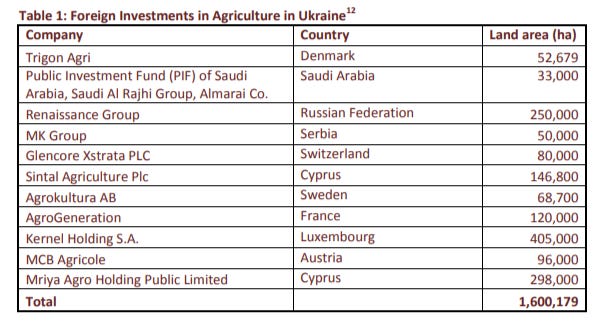
That shows 1.6m hectares out of a total of 40+ million in Ukraine.
As for Cyprus, this legal site states that Cyprus has always been one of the top investment vehicles into Ukraine. It lists some of the advantages:
Royalties, dividends and interest paid from Ukraine to Cyprus are not taxed at all. Mergers and acquisitions may be carried out without taxes.
UkrLandFarming which I believe is the largest agriculture company in Ukraine ranks as world’s #8 largest in terms of pure acreage of owned land. The company was founded and registered in Cyprus in 2008. Its parent corporation of Avangard Agro Holdings is also Cyprus registered. As you said, it doesn’t necessarily mean much as it’s a typical tax haven, and much of the info in general surrounding Ukrainian agriculture is mixed up with tons of erroneous stuff from very sketchy websites with no sources, which mainly just use ‘assumption’.
In reality, it’s difficult to know exactly how compromised Ukraine’s farm land is. Most of it appears to be owned by one man, Oleg Bakhmatyuk who is the owner of UkrLandFarming. But particularly since 2014, his businesses have taken major losses due to the ongoing conflict and the loss of much of his farmland in both Donbass and Crimea, which he used to own. That means he’s been forced to make backroom “deals” and concessions with foreign companies, so we can safely assume that there is likely a lot of shady things going on with foreign takeovers, as Orban implied. However there is simply no direct data or evidence yet of such large scale takeovers. With that said, the data we do have is fairly old and obsolete so there’s a good chance that a lot more of the land has been taken over since then, but simply not reported on due to the ongoing war/crisis.
6.
My question is about red lines. There are always talks about red lines for Russia that Ukraine and the western sponsors cross and do not care about. Are there real red lines for the West that once crossed by Ukraine would cause western sponsors to get really afraid, disown Ukraine and force Zelensky to ask for peace talks? Something like attacks against Moscow with mass casualties? Perhaps a desperate Ukraine might start a bombing campaign against civilian infrastructure in large pre-war russian cities just for the propaganda.
There are many openly stated, implied, and secret red lines for Ukraine from their Western handlers. An example of an open one was how the U.S. reprogrammed its HIMARs rockets to literally not be able to function in Russian territory, as reported by the Wallstreet Journal:
Now Germany too is considering gimping their Taurus missiles before potentially supplying Ukraine:
There’s now big hubbub about U.S. allowing strikes on “Russian territory” vis a vis Crimea, but we must recall that U.S. does not officially consider Crimea as Russian but rather as Ukrainian territory. On Russia proper, U.S. reportedly continues to disallow Ukraine from striking with its weapons.
More hidden red lines likely revolve around hitting sensitive sites or using other goading measures to try to get Russia to attack a NATO member, for instance.
The biggest internal red lines would likely be about hitting Russian nuclear assets, whether it’s power plants which could cause a Chernobyl-like mass catastrophe, or nuclear triad sites, whether it’s ICBMs or nuclear capable planes. Of course, we’ve already seen Ukraine reportedly attack the latter of these, with an attempted strike on Russian Tu-95s. However that could have been Ukraine’s desperate attempt to gain attention from their sponsors and may have resulted in sharp internal censure, which is why we haven’t seen even an attempted repeat of such an attack since.
I think your ideas are correct in the types of attacks that could give Western sponsors cold feet or cause them to consider disowning Ukraine, however as I’ve written about before, Ukraine is not fully reigned in by the West. There are tantrum-like disagreements which I’ve always predicted would become more and more common the closer Ukraine comes to its inevitable end. That means the more backed into a corner they get the more dangerously will they begin to skirt the redlines in an attempt to provoke their own allies and send a sharp message to them.
I’ve said before how, as Western support wanes, Zelensky may become so unhinged that he will deliberately attempt to start WW3 by creating the types of strikes that could pull the U.S. or NATO into direct war with Russia. The goal of this would be to scare the West into increasing their financial/weapons support. It’s basically “nuclear blackmail,” and I believe we’ll see more of it as Ukraine gets down to the dregs, which will be a particularly dangerous period—like a feral animal backed into a corner.
This by the way is likely one of the reasons U.S. has withheld certain things like long-range ATACMs missiles or even the upgraded longer range GL-SDBs for the HIMARs. They could be afraid of how Ukraine will utilize them in deliberately provoking a redline that would force the West into the war.
I once wrote that Ukrainian missile/drone strikes on a nuclear power plant like Zaporozhye NPP would not be effective, as smaller projectiles of that sort would likely not even penetrate the containment building. But a huge ATACMS ballistic missile on the other hand could instantaneously create a nuclear catastrophe. A rabid, unhinged Zelensky could perhaps conceive of such a thing once he feels there’s “nothing to lose.”
Generally the red lines against mass civilian terror events for the West are for practical reasons. The U.S. wants to be able to “sell” the war as a justified one, of an innocent defender against a brutal aggressor. If Ukraine veers too heavily into open terror then Ukraine’s sponsors will find it increasingly difficult to sell the war to their own public.
A follow up from a different person:
I'd like to follow up on the previous question in light of Joe Biden's corruption: Can the current U.S. government even afford to withdraw from Ukraine? There must be a lot of incriminating material on Biden on the Ukrainian side. If Biden disappoints the Banderists, they will be able to pass the deals to the U.S. judiciary and the whole Biden family will be busy with trials and jail terms for the rest of their lives. So my question: Can Biden withdraw from Ukraine - even if he wants? And can Biden afford to lose the US elections? Thanks to Biden's corruption, the future for the world as well as the US seems very bleak...
That’s a good point, and it’s one of the reasons I previously wrote how I believe as Ukraine gets closer and closer to teetering on the brink, Zelensky will become increasingly unhinged, threatening to expose his Western backers’ dirty secrets as blackmail for continued support in the war.
So it certainly is a very complicated situation where there are clear incentives for both sides. On one hand to stop the clearly disastrous war, which will look more and more disastrous for the sitting administration as the months go on, but on the other hand, the need to continue it so as not to risk exactly what you outlined.
However, the one trump card they have (no pun intended) is by simply getting rid of Zelensky. You see, in recent months many of Ukraine’s top leadership has already been purged, guys like Reznikov and others who have potential dirt. Just today another huge purge occurred: the cabinet of ministers fired all 6 defense ministers of the country:
The final one that remains is Zelensky himself, and there have been increased talks lately that U.S. may end up axing him by the end of the year. They may not even have to do it “messily” because the presidential elections for Ukraine are early next year. Poroshenko and others have already been building themselves up for a return while U.S. officials have placed pressure on Zelensky to have the elections. Lindsay Graham recently posted a video nearly demanding that Zelensky run the election. This could be the U.S.’s “hedge play” where they may intend to replace him early next year with another more amenable candidate, who perhaps can freeze the conflict without exposing any pesky and unnecessary dirt on anyone.
They may let the offensive run its course enough to build up some bad karma on Zelensky and then threw him under the bus with a campaign of blame, so they can get rid of him if need be, should he signal any ‘bad intentions’ of the blackmail sort.
As for whether Biden can afford to withdraw from Ukraine for his own political career. Well firstly, I don’t believe there’s any way Biden can conceivably run for re-election. I believe his people are just putting on a show to give an appearance of virility and strength but in reality, I question whether he’ll even finish his term.
So as far as Biden’s own administration I don’t think it matters, as he’s a goner politically anyway. However, the failed Ukraine conflict will still look bad on his administration and anyone who supported it in general, which will give huge ammunition to all opposition figures in blaming them. Thus even whoever the democrats choose to replace Biden will likely “inherit” the tarnished reputation from the Ukrainian conflict. This means I agree with your view that—rather than Biden himself—the establishment in general “can’t afford” to lose in Ukraine. However, given no choice—if Russia really decisively ups the ante soon—they may have to compromise and try their best at finding a temporary solution in the form of ceasefire that can be sold by loyal media propagandists as a “victory” of some sort.
7.
With the new round of escalations with the U.S. providing the long range missile to Ukraine which, of course will hit Kerch bridge again or Moscow, do you think that Russia will hit the targets on the U.S. soil to wake the Americans up to the danger of what's going on?
Firstly, that missile doesn’t have anywhere near the range to hit Moscow. In fact it just barely even has the range to reach Kerch bridge, which means they’d have to fire it from fairly close to the frontline to even reach Kerch, making it dangerous for their own firing unit in getting spotted and destroyed.
But as for Russia hitting targets in the U.S.? No, that won’t happen and is not necessary. Of course many Russian ex-generals and politicians are increasingly starting to call for striking NATO assets in Europe, like U.S. bases in Poland or Germany where much of this stuff originates. But that’s unlikely to happen as Putin appears to have too much of a ‘cool head’ to risk starting WW3.
The main reason I don’t think it will come to any of that though is because I don’t even think the missile, if it’s ever even delivered, which is still in great question, will have any effect or even be able to hit any real targets. The ATACMs is a slow ballistic missile which can’t be “mass fired” in large saturation salvos like the regular HIMARs. Given that it’s much larger and is not hypersonic like Russian ballistic missiles I’d give it a very low chance of being able to penetrate Russian AD nets around any truly valuable asset like Kerch bridge.
The only place it could successfully hit are frontline areas that aren’t as well protected by truly anti-ballistic missile capable systems like S-300/400. Local SHORAD systems like Tor/Pantsir aren’t made for shooting ballistic missiles and could fail to detect it just owing to its trajectory. Its launch would be much too distant for SHORAD to detect, and its downward ballistic arc would come in “over” the radars, out of their scope of elevation.
So frontline areas could be at risk but important rear areas should be able to block the ATACMS. After all, Russia has already regularly shot down Ukraine’s Tochka-U ballistic missile, which actually travels much faster than the ATACMS so we know for a fact Russian enterprise systems can knock these down easily.
8.
My question: I read that Finland sign a treaty where they got land from Russia but they need to stay a neutral country, can you comment on this? Implications? Is it true?
I assume you’re referring to the Finno-Soviet Treaty of 1948 which led to the Paasikivi-Kekkonen Doctrine of neutrality. Although the land concessions really happened with the earlier Paris treaty of ‘47 and Moscow treaty of ‘40, after the Winter War. It’s a bit confusing because Finland had one of the most confusing roles in WW2, however it can be said that Finland did not gain territory but rather lost it. In the first part of the war, they lost territory, then they gained it back by joining Nazi Germany, however in the later treaty, they were returned back to the earlier position. This meant in general, Finland ceded land to Russia rather than the reverse; or another way of saying it was that at the end of WW2, Russia continued to control more Finnish land than before the war.
However it’s true that Finland was obligated to stay neutral, neither participating in military blocs with the West nor the USSR. However that treaty expired with the fall of the USSR in 1991 so it became irrelevant anyway.
Though I will say, much of the neutrality had less to do with the treaty per se but more with the political doctrines that the Finnish presidents maintained. The treaty itself expired every 20 years or so and was renewed by those presidents who wanted to maintain the neutrality.
My point in that distinction is that the real power of neutrality was not in the treaty, which was temporary anyway, but in the political will of the leadership. Thus, in the modern era, the political leadership clearly has been compromised to the West’s interests and no longer has that same will to stay neutral. So treaty or not, it wouldn’t have mattered. Once your country becomes subjugated by the West in such a way, there are no impediments to full vassalization under Anglo-hegemony.
Here is a survey conducted in Finland at the start of the Ukrainian war showing Finnish positions toward joining NATO:
One can see that classically, for the past two decades, over 50% of Finns were against joining NATO while the “pro-NATO” crowd held at round the 20% mark. At the start of the SMO, that suddenly jumped to a massive 60% being for and a tiny percentage against.
Such major leaps in any population are highly unnatural and usually the result of some “tweaking” or major propaganda campaigns, which is likely the case in Finland. You can see that even during the annexation of Crimea and Donbass war of 2014 things didn’t shift too much.
As to the implications of this—well, since the treaties were long gone it doesn’t really matter in that regard. The only real implication is now Finland will be treated as a hostile country and will have Russian nukes pointed at it, with increased Russian military presence on its borders. NATO is also now using Finnish airspace to conduct surveillance flights and Finland will now likely play a big role in the U.S.’s new ‘scramble for the arctic’.
However, most Finnish people are against all of this and I predict that in the future, after the end of the Ukrainian war and grand weakening of NATO, Finland will be one of the first to turn back to the fold, as all of these illegal actions were brought against a reluctant populace.
9.
Here is quick (to ask) question.
With Russia and Russian society more and more on the war footing, with their MIC ramping up, and with the West essentially demonising them and shutting them off, how do you see the whole thing winding down, if at all?
And as a follow up, if it does not wind down, where do you see this going in 5 to 10 years?
At this point in time, I see only escalation options, and this is without even mentioning the Chinese question. It is very easy to start a fire, but sometimes near impossible to put it out.
As you mentioned, Russia is getting stronger by the day, ramping up their industries. They are improving in every military facet, getting better at killing, which will lead to an increasingly larger discrepancy in the losses. There’s even been a recent report showing that one of the latest Kondor-FKA recon sats Russia sent to orbit allegedly took immaculately crisp photos of U.S. naval properties in Pearl Harbor, showing how far Russia is coming in every respect.
This is all to say that one of the ways things could end is that in the next year or two, Russia will become so streamlined at destroying the AFU that Ukraine may simply face collapse. The likeliest way such a thing would happen is a military coup to overthrow the presidency and take control of the country, carried out by sympathetic generals who are tired of seeing their men get massacred and know from a military standpoint that no hope remains for any sort of victory.
Russian ‘special services’ always have their finger on the pulse of such people and there are secret backlines that exist for eventual contact. I.e. once Russia senses the generals are beginning to dither, messages will be sent to explain that amnesty will be offered for full surrender, various deals worked out for surrender and subsequent capitulation, etc. These generals can then proceed to form an interior group of like-minded subordinates who’ve had enough. They can take control of the country then hand it over to Russia after effecting a mass surrender.
The other possibility is that they hold out forever, continually retreating further west into the interior country of Ukraine, forcing Russia to chase their holdouts for years. This could make the conflict drag out for 5 years if not longer.
Just days ago, Russian State Duma Deputy Chairman Pyotr Tolstoy said that the conflict will go on for years:
“It won’t be quick. There is serious resistance, the enemy is tough. We should not underestimate the fact that almost all countries are supplying [Kiev] with weapons and materiel. Ukraine has nothing of its own, it is fighting only with what it has received,” the lawmaker stated.
I don’t see things in absolutes but only as scales of probability. I do think the highest probability goes to the first option I gave, with Ukraine crumbling and surrendering at some point in mid 2025, though end of 2024 is possible, just not super likely.
The reason is, we can see that Russia may not even start serious offensive options until at least the spring 2024 season, likely spending the winter doing stand-off strikes to whittle down Ukraine’s infrastructure. If Russia hypothetically carries out major offensive operations throughout 2024 I can see them bringing the AFU to a dire point, but it will likely be able to last at least another offensive season as it would be on its last gasp. Then 2025 could bring the final killing blow. This is also calculated in terms of Russia’s current troop dispositions and enlistment pace. I don’t expect a true critical mass of troop numbers to occur until well into 2024 which would mean they would not be fully utilized to their full potential until perhaps 2025.
However, if Ukraine manages to hold on, or Russia’s offensive capabilities turn out to be not as effective as we hoped, then it could very well continue grinding out much longer. This could give NATO more time to arm the next placeholder, like Poland, and begin provocations to make Poland the next theater in order to keep stringing Russia along into a forever war to keep Russia continually tied up and weakened.
People have asked me before how such a thing would be possible if the countries surrounding Russia are in NATO, and any such hostilities would trigger Article 5. I’ve said before that Article 5 is not sacrosanct and does not actually even mean much. I believe the U.S./NATO—if need be—will allow Poland and the Baltics to fight Russia without triggering WW3 level escalations through Article 5. Anything is possible in their quest to plunge Russia—and Europe—into forever war to: 1. weaken all competition and 2. mask the collapse of the Western financial system.
So that’s where I see it going on the longer timescale, the continued eventual attempts to bring more countries into the fold while U.S. “leads from behind”. Recall that U.S.’s chief tried and true tactic in any great land war is to always let the combatants fight it out and destroy each other for a few years first, then stage a falseflag (Lusitania, Pearl Harbor) to enter the war at the tail end and proclaim themselves the chief victor/savior—while subsequently restructuring the entire global financial system in its favor, after stealing all the wealth.
At the current rate of losses however, and given the fact that the supply of major critical heavy armor, artillery, etc., will by necessity drop to a pittance, I still favor the outcome where Ukraine will be on its last legs by middle/end of 2025. An internal U.S. army Fort Benning report predicted the U.S. would likely have to fight Russia around 2025:
It happens to coincide with when Ukraine will likely be facing total collapse.
I still hope that the upcoming Russian offensive action is decisive enough in its capability to prevent such a clash. However, it remains to be seen if Russia can uproot a truly fortified enemy once Ukraine digs in and goes on the defensive. So far Russia’s ISR capabilities haven’t needed major flexing because it was the AFU that’s gone out in the open for their offensives, exposing themselves to destruction. But in the coming march forward, Russia will have to be able to identify a dug-in enemy in order to inflict enough fire damage on them to keep up similar attrition levels to the present, otherwise Ukraine could last for a long time. So everything will depend on how well Russia does decisive offense in the coming days.
10.
What is the US's end game here with the constant drawing of their own red lines and then constantly stepping right over them. First it was cluster munitions, then DU, and now it's ATACMS....even going back to the Obama and Trump administrations first it was "no lethal aid" and then Stingers, and then after the SMO began it was no HIMARS and then they gave them HIMARS ...so what's next? F-16s w/ nuclear armaments?
They must know that these are increasingly just escalatory tactics, and that Ukraine is running out of cannon fodder to throw into the meat grinder. So there must be some sort of goal other than getting rid of old(ish) weapons so the MIC can sell more. Do they think that with every passing day/week/month that Putin is more likely to face a coup or total collapse in Russian public opinion? Or is the goal more US domestic politics related whereby they want to keep the war raging, with occasional (often delusional) headlines until after the November elections in 2024? Or is it one or both of those AND a suicidal (for the Earth's people) attempt to goad Russia into a major retaliatory action should a ATACMS be used across the border into Donbass or Crimea or even Russia's pre-war mainland so as to "justify" some even more insane action up to and including "tactical" or even real nukes? If there is one country and its leaders in the history of post-atomic humankind who has not only used nukes, but openly expressed the will to do it again and again, it's the USA.
Much of this I answered in the previous question about red lines, but in the second part you bring up a good question.
Many people are wondering where is this all leading? Surely the West must know Ukraine stands no real chance of “winning” in any appreciable way, whether we define victory as completely destroying the Russian army or recapturing all the borders back to pre-2022 or even pre-1991 (Crimea).
I believe they do know this. Thus the ultimate goal is not to win kinetically or militarily, but rather to stretch out the conflict for as long as possible in order to create time and space for them to work the more subversive, under the surface war against the Russian public, elites, government, etc. In short, they want to increase the pressure on Russia’s political structures to maximize societal tension and eventually bring about some sort of political turmoil. A coup/maidan-style scenario would of course be ideal for them, even if it’s unlikely.
This is what economic sanctions were all about, as well. Not to mention the blocking of SWIFT, the destruction of Russian culture and repressions against their citizens all over the world—whether it’s bans from Olympics and other international competitions (chess, etc.), or restrictions like the ones just announced, where Russian cars are being banned from entering Europe, Russian people humiliated by customs inspections, etc.
All of this is meant to generate dissatisfaction and most importantly societal fatigue, such that the people will have “had enough” and begin to agitate against Putin and the elites. The Russian presidential election is coming up in March 2024. One ideal scenario for Western planners would have been for people to have gotten so fed up that they oust Putin by choosing a new candidate who promises to “bring an end to the pointless war, and restore Russia’s cherished economic relationships with the West.”
The problem is, all the sanctions failed, all the repressions and humiliations have only unified the Russian people with even more solidarity. New poll numbers just this week show Putin’s approval rating still sky high at 77% while new economic numbers show Russia again making record profits as oil prices have recently gone up, not to mention Russia began decreasing its ‘discounts’ to India and others.
So that was the true goal of the West—to make the war last long enough for them to demoralize Russian society into overthrowing or voting out Putin. Though it’s clearly failed, they likely believe that given enough time it can still succeed eventually, so they will probably keep trying.
As for the U.S. elections, I said from the beginning of this year that the U.S. elites would give Ukraine until the end of this year and then try to wrap the war up so that it doesn’t tarnish the 2024 election cycle, as it will be viewed as a humiliating failure akin to the Afghan withdrawals for the sitting administration. However there are several layers of factions to this war. The most superficial layer of American politicians and technocrats will want to wrap it up, but their higher up controllers—the multinationalists who work for global finance, Rockefeller/Rothschild and the top of the banking pyramid—they certainly want the war to go on in order to mask (and ultimately reset) their collapsing financial system in the same way they did with WW2 during the great depression.
But you’re right about one thing, the U.S. is the only country to have used all three of the officially known types of Weapons of Mass Destruction:
1. Nuclear - on Japan
2. Biological - agent orange on Vietnam (not to mention clandestine biowarfare like Covid and many other programs used on the whole world)
3. Chemical - white phosphorous, depleted uranium, etc., on a slew of countries
11.
Any interest in investigating the money trail on building and individual death insurance payouts for 9/11?
I’m interested in reading about it but not investigating it myself. My official stance on the 9/11 stuff is that the actual details of how exactly it transpired aren’t really necessary or even particularly interesting to me. Ultimately we know generally who did it and more importantly why.
And for those interested, I went into detail of the true reasons for 9/11 here:
But I do believe that no plan of that scale is ever carried out without having multiple subsidiary facets to it. Because there are always “multiple birds” you can conveniently kill with one stone, so why not do it when you have the chance? That’s why I do believe there were many subordinate objectives that were simultaneously fulfilled during the 9/11 false flag attacks. Some of those include the various insurance fraud schemes, like the allegations around Larry Silverstein and co. And also the strange military/IRS records disappearance—i.e. the infamous story of Rumsfeld announcing $2.3 trillion in missing funds literally the day before, on 9/10, and the subsequent destruction of a lot of Pentagon records. There were also the stranger tales of gold vaults beneath the WTC being exfiltrated, and things of that nature.
I’m sure most of it was a coordinated effort to use the event to wet as many beaks as possible so that all parties were “satisfied” in their take for the risk they ventured. But as I said, at the end of the day, the exact details of much of it are not absolutely critical to me as long as we understand the general motivations for why it was done and by whom, which you can find in my article above.
12.
What keeps the Ukrainian soldiers attacking when they're always suffering such high casualties, and is this behavior unprecedented in terms of the casualty rates?
Because they have to continually create the perception of success and advancement in order to keep Western interest float, so that their sponsors continue providing them with arms. If they were to stop attacking even for a month, headlines would flood the world about the Ukrainian army being ‘broken’ or finally having collapsed and unable to fight. This would lead to very uncomfortable public opinion in European countries that would put heavy pressure on Western leaders to cut down on the funds and arms shipped to Ukraine.
You have to remember that Western/European leaders risked a huge amount in convincing their public that supporting Ukraine was crucial. They told their public for months that they (the public) would have to endure heavy hardships and burdens in the form of not showering, not heating their house, suffering extremely high inflation, etc., all to “defeat Putin”. The public bought this because they were under the impression that Ukraine was winning. When you feel that victory is close, you will be able to bear such hardships because it feels worth it.
But as soon as victory no longer looks possible, your morale for bearing hardships will dwindle. European support to Ukraine is hinged on the European public believing that the war is winnable or that Ukraine is actively advancing and is “close to winning” in some way, shape, or form.
If Ukraine stopped attacking it would be construed as an admission of defeat, that they can no longer advance. Why would Europeans want to continue withstanding no heating, no showering, record high inflation and unemployment, etc., if there’s no further hope for victory?
So as you can see Ukraine is forced to continue sending waves of men to die just to appease their sponsors and make them believe that some form of progress is being made, all their hardships are not for naught.
As for whether these casualties are unprecedented, it’s hard to say. Certainly they’re not unprecedented for WW2, but in terms of modern warfare they may be. The Iran-Iraq war in the 1980s had a claimed 200-600k dead on each side, but it lasted 8 years. If we don’t count internecine civil wars like the Rwandan Genocide which saw upwards of a million killed in a matter of days/weeks, then the only other war of this casualty scale I can think of is perhaps Vietnam, where it’s claimed over 1 million North Vietnamese died, but that too was over the course of what was effectively a 20-year long war.
If the absolute worst of the casualty estimates about Ukraine are true, i.e. 400-500k dead in only a year and a half of war, then it’s probably the highest casualty rate of the post-WW2 period that I can think of. Hell, it might even be higher than WW2 when you consider the fact that an estimated ~1.5 million Ukrainian military men died in WW2 over the course of 4-5 years. If it’s true that 400-500k have died already in 1.5 years, then they’re on course for even beating their WW2 figures.
Of course most still believe Ukraine’s casualties are much lower than that. I myself do, or did, but there have been increasingly troubling reports recently that point to the higher end of the casualty list. For instance, yesterday’s admission from the head military commissar of Poltava said that the casualty rate for everyone mobilized from his region is upwards of 90%.
As LordBebo calculated on Twitter, this would extrapolate to the entire armed forces as follows:
So if Ukraine mobilized 700,000 people and had an army of 300,000, a total of 1,000,000 You can project losses of about 800,000: - out of which 400,000 would be wounded, roughly half can return - 400,000 killed
If that’s even remotely the case, then certainly the casualties dwarf every known conflict, probably even including WW2.
13.
Following up on the “Russian propaganda” issue please point out as specifically as you are able to do it, what are in your considered opinion the major Russian state (hidden/subrosa)propaganda efforts viz the war?
Surely you have had to vet and consider virtually everything out there. Just as surely the Russian state cannot ignore the fact that effective persuasion is an essential arrow required to be in a quiver for modern warfare. We know that real Russian propaganda is out there beyond just RT and standard “our point of view” stuff. What is less obvious? Where is it? What should be avoided. What do you toss out? How effective do you think such efforts are?
Firstly I’ll say that to a large extent Russia doesn’t need propaganda because the truth is on Russia’s side in this conflict, which means that a lot of the people fighting the “information war” on Russia’s behalf are doing so simply due to their own internal desire to fight for the righteous cause against those who are doing obvious evil.
The problem for Ukraine is they’ve badly miscalculated many of their propaganda thrusts, making it almost too easy for Russia. For instance, the way they’ve doubled down and “leaned into” Ukraine’s obvious “Nazi problem” has completely discredited their efforts. Instead of somehow finding a middle solution, admitting the issue is a big one and perhaps launching a campaign to convince the public that such elements have been expunged, they chose instead to outright lie and pretend that it doesn’t exist, and anyone claiming that’s the case is merely “a Russian propagandist”.
The type of behavior like that of this Western mercenary fighting in Ukraine is what I’m talking about:
When you are lacking any self-awareness to that degree, you really make the propaganda war easy for Russia.
But to answer your question more directly of what Russia is doing actively in this sphere, common sense tells us there have to be clandestine efforts to amplify the Russian narrative. But such efforts remain well-hidden because everyone claims Russia has completely “dropped the ball” and given up all control of the narrative.
Also it depends from whose side you want this answer. For instance, according to the U.S. Russia has been engaging in clandestine efforts to spread “propaganda” in the country. They’ve arrested some Russian nationals in Florida months ago who allegedly had contact with the FSB and were actively agitating in the U.S., or so they claim:
I always cross-reference everything I can in order to avoid what you suggest—being propagandized by one particular source which may potentially be ‘compromised’. That’s why I don’t make any significant ‘reads’ on a particular given situation unless it’s been cross-referenced from a variety of sources to my satisfaction. Not to mention I have my own contacts/sources on the ground that can verify certain things, depending.
Ultimately, Russia’s “propaganda” is either extremely powerful and clandestine such that we can’t even see it or it’s completely hamfisted and/or nonexistent, because I don’t really notice overt examples of it anywhere. All the “Russian propaganda” accusations from NAFO/West type of sources are just infantile whinging at people who have no real ties to any official Russian state organs.
14.
Given the horrible casualty rate in the AFU, what are the Ukrainians waiting for to revolt against their government, pardon, dictatorship? Why do not conscripts turn their weapons against their commanders and all the way up to Zelensky? Have they been completely brainwashed and lobotomized by NATO propaganda?
(There are 3 question marks, but the first two questions are really the same and the third is a corollary question).
I mean: if I was a Ukrainian forced to go to the frontline, I would risk my life killing my commander(s) to try to set free my country rather than dying at the front, serving a drug addict and American interests.
Thanks for your time and keep up the good work!
Unfortunately it’s how human nature works. When under extreme duress most humans ‘freeze up’ and cannot act in a way that could save their life. For instance, you may have seen famous videos (like from ISIS, etc.) where a line of people are set to be executed. I’ve seen such videos where the POWs were not even bound, and were merely being marched to their deaths by one or two captors.
If the POWs wanted to, they could have turned on their attackers and risked their lives with a fairly good chance of overpowering them. But unfortunately human nature seems to freeze us, and instead they typically sit and watch the other guy in front of them get shot first, one by one, and are unable to muster the strength to make a go at the executioners.
Similarly, Ukrainians are going with the flow because they’ve deluded themselves into the hope that perhaps things will turn out all right. It’s a combination of everything from cognitive dissonance to normalcy bias.
But to a great extent, what you said is also correct. They do get actively brainwashed by special Western “psychologists”. This is very commonly heard in interrogations with newly captured prisoners, for instance this one from just last week: Video Link. But here are some other semi-recent ones as well, which relate the same thing: Video 1, Video 2.
Also, there were numerous videos of POWs stating that they were strictly taught that Russian captors would do all kinds of atrocities unto them if captured. They said they’re taught that Russians cut out their tongues, castrate them, and various other horrors. They are terrified when caught and are shocked to be treated well.
On top of that, information is strictly withheld from a lot of them, and they are taught that they’re winning and Russia is close to collapse. I wish I could find the video, though it’s somewhere on my channel, but several captured Ukrainians earlier this year spoke about how in their battalion information was so strictly controlled that when they were captured they were shocked to learn that Ukrainian troops were not occupying Belgorod and other major Russian regions. They were told that Ukrainian forces had already captured Belgorod and broke through several regions, and would soon be able to even march on Moscow, etc. This is the type of wild propaganda they are fed.
However, there are many, many cases of Ukrainians already getting violent with their commanders, commissars, etc. For instance: Video Link.
Or this (warning, graphic 18+): Video Link.
And the earlier mentioned “battalion worth” of men dying in the rear, though much of it can be attributed to partisan action, I wouldn’t be surprised if much if not most of it is also a result of angry troops killing their commanders, etc.
Ultimately, as I said in an earlier answer, I do foresee a Ukrainian collapse by way of mutiny and eventual military coup as one of the most likely probabilities, so I think we will get to the breaking point you speak of eventually. But for now, Ukraine is enjoying far too many “media victories” for that to happen. It’s easy to convince their troops they are doing well and thus keep up a semblance of morale. After all, they are making quantifiable progress on many fronts, even if it’s playing into the deliberate Russian tactic of an elastic defense to bleed them dry.
15.
I recall in the first year (or so) of the SMO there were quite a few prisoner exchanges and it was always lopsided: two or three hohols for one Russian because clearly the Russians have, and continue, to capture far more Ukes than the other way around. It seems that the number of prisoner exchanges have dropped of considerably and the hohols are demanding exhorbatent exchange ratios like 10 or more Ukes (often of fairly high rank) for even a single Russian private. That interview you posted recently with that Russian prisoner is evidence of this. Russia clearly just wants to get their guys back and protect them from torture and mistreatment, but what is the Ukrainian game here? Do they just want to basically halt the exchanges to make is slightly less obvious that more and more of their guys are surrendering? Are they desperate and think that maybe the Russians are so concerned to get their guys back that they might really make these lopsided deals? Or am I off base and the exchanges are just still going on and I am not hearing about them?
You’re right that it appears the current POW ratio is at the most disproportionate it’s ever been. Recent reports from Ukrainian sources complain that “Russia has been refusing to do exchanges recently”. So you bring up a good question as to why that may be, if it’s true.
The obvious educated assumption is that, as you said, Ukraine itself has been making increasingly lopsided exchange requests, and so Russia may simply be rejecting these offers, which Ukraine then uses as fodder for propaganda. The reason would be that Ukraine is very low on Russian prisoners.
Along with the POW interview I posted, you may recall I also posted an interview with Verkhovna Rada ombudsman Dmytro Lubinets who outright admitted that their POW exchange fund is uncomfortably low or nonexistent:
Longer excerpt:
The Kiev regime does not have so many prisoners of war to crank out the “all for all” exchange - Ukrainian Ombudsman Dmytro Lubinets.
“There is a figure, we do not name it publicly. What about the exchange fund - I constantly hear this question from relatives. We publicly said yes, we have problems with the exchange fund.
This means that we do not have enough Russian prisoners of was, whom we want to exchange for Ukrainian prisoners of war. They exist, the number is not enough, and this is also a problem,” said Lubinets.
First of all, this plays into the hands of Russia, since any negotiations take place in a dominant position, and even an agreement on unequal conditions demonstrates a desire to meet and reach compromises, putting the lives of fighters as a priority.
So they have almost no Russian POWs, meanwhile Russia is said to have as much as 18,000 of theirs. This would explain why Russia may have “stopped doing exchanges” with them recently. They are making very unreasonable requests like “We’ll give you one of yours for 100 of ours.” As you said, the Russian POW said Ukraine wanted 20 of their men in exchange for just him. So it’s only logical that Russia would reject such offers, leading Ukraine to moan about no exchanges happening anymore. You can see another example in yesterday’s video, where a DPR commander offers to exchange a Ukrainian POW to his own AFU commander, but they have no Russian POWs to exchange.
Thus to answer the question, I think halting exchanges is likely done because Ukraine is deliberately making unreasonable offers in order to pass it off as Russia being the one that’s refusing the exchanges. This is to characterize Russian officials as cold-blooded or uncaring about their men, but is in actuality an attempt to conceal Ukraine’s own inability to get their men back due to not having enough Russian POWs.
16.
A recent strike on an ammo depot in Kiev was said to have hit western munitions, including those with depleted uranium. Are there any sources for detecting this? Last time radiological data from Poland seemed to show results of a strike in western Ukraine.
I assume the big strike you’re talking about is the one that took place at 49.623573, 30.657520 coordinates south of Kiev on around September 10th:
🇷🇺🇺🇦 Last night, kamikaze drones "Geran" destroyed a military arsenal in the Kiev region, NASA satellites recorded more than ten sources of fire in the territory of ammunition depots after 3 am.
Object coordinates: 49.623573, 30.657520
Local authorities confirm the arrival at an “infrastructure facility” in the Kiev region, without specifying where and what arrived. Only the consequences of the blast wave in the form of damaged private houses are mentioned.
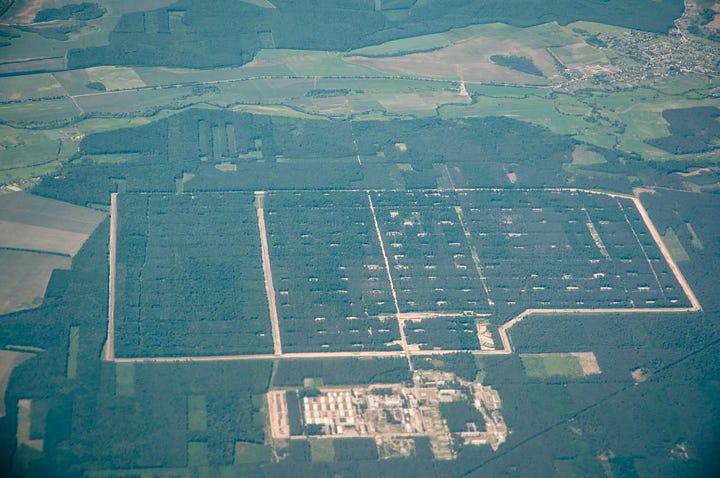
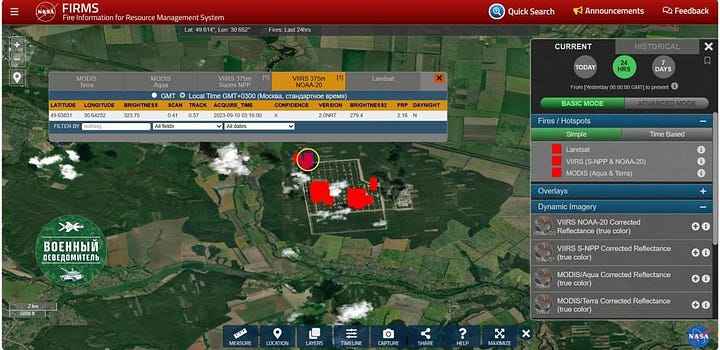
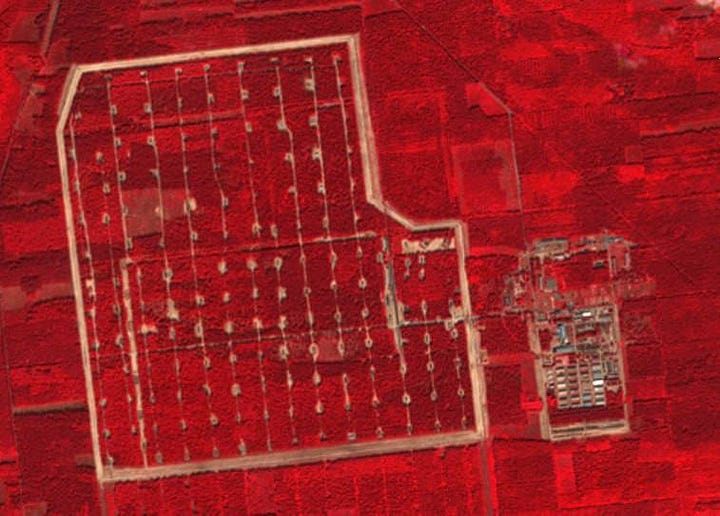
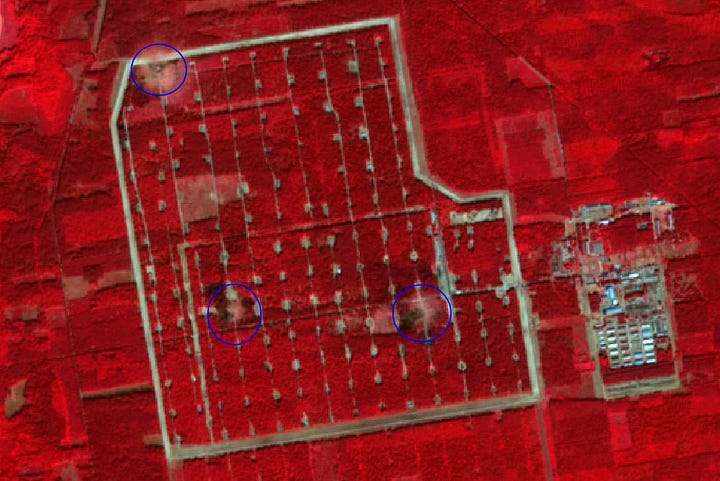
Though I didn’t hear anything about depleted uranium in that particular strike. However, this was the report where I went into detail about the big Khmelnitsky strike months ago which was said to have raised radiation levels.
As of this writing though, there’s a new reported strike by Russian MOD specifically on DU sites:
They don’t specify where but mention that Kiev announced another strike on Khmelnitsky, as well as Odessa, so it’s likely one of those two places.
But the above strike on southern Kiev of which you were speaking: You can see above I also posted NASA FIRMS hotspot map, which I suppose could be used to detect not radiation itself per se, but an object that’s burning for way too long which could perhaps indicate some kind of depleted uranium source.
Also a new internal leaked chart for the entire warehouse / base was released and showed that the exact bunkers corresponding to the maps above that were hit, are on this registry marked as “special mines/shells and charges” and “mine clearing charges”.
So apparently warehouses full of mine clearance charges, perhaps MICLIC and UR-77 ropes, were hit as well as some kind of “special” shells. Perhaps that could be DU stored there.
Apart from that there’s no other source I know of other than the standard ones, i.e. specialized detection stations in places like certain universities. Last time it was the Maria Curie-Sklodowska University in Lublin, Poland which apparently has special instruments for detecting Bismuth in the air, which was said to be a byproduct of depleted uranium.
The south-Kiev strike is likely too distant from other countries, but the new strike last night—if it did take place in Khmelnitsky—could begin setting off detectors again, so we’ll have to wait and see if news of that comes later or tomorrow.
17.
who are you?
.
.
.
.
.
.
̵̡̢̡̢̢̨̛̙̪̦̭̠̱͉̝̻̦̰̺̪̮̣͚̟̹̗̖̤̙̣͇̠̟͓̰̈́̑̏͛͑͊͒̂̊̄́́̊̈́̈́́͌́͗͂̓̓̈̊́̊̑̃̈͒̀̌̏̌͊͐̐̃̂̒̃͋̆̓̅̓̋̒͋̍̃̍͘̕͘̕͘̕̚̕͜͠͝͠ͅͅͅơ̶̡̢̨̢̛̛̗̻͚̝̭̫̯͔̝̝͔͇͚̜̦̗̦͚̠̲̥̔͐̏̆͂̀͐͑̃̌̈́̉͆̉̐͐̈́̓̃̈̂͐̆̈́̈́͒̊̾̍̔̈́̿̋̈́͐̋͐͆͒̈́͂̏͌̅̆̇͒̌͋̊̈́̅͌̈́̀̉͛̚̚̕͘͘͜͝͝l̷̢̨̨̛̛͍͈̞̣͔̙͈͎̖̭̼̝͎̪̖̎̋̔͌͆̄͆͌̀̑̋͑̌̔̋̐̈͆͌͗̽͊̊̂̓̽̋͆̆̒̔̓͂̉́̽̋̍̏́͊͒̈́͛͋̅̈́̌̃̈́̋͛̓͘̕͘̕̚̕̚͜͝͝ư̶̡̨̢̡̧̡̢̨̼̬͕̬̳͎̙̯̮̘̤̼̝̜̯̥̤̲̯̼͓̘͇̱̳̻̩̥̘̝͎̦̳̩̳̺̫̮͂͌̃͒̈́́̄̏̾́́͐͒͐͐̀͒̏̈͌̅̔̎͆̒̔̏̐̄̇̿͂̿̓̎̀̎͋͒̋̓̈́̕͝͠ͅͅç̶̧̨̡̭̭̦̻̼̱̟͇̞̪̘̳͎͉͖̟̱͔͕͖̲̝̯͖̞̖̜͎̣̼̩͍̬̩̮̗͎̠̗͉̜̺̯̺̳̝̩̣̜͇̠̲̳̺̳̲͙̰̬̪͔̠̮͉̤̗̮̥̠̖̒́̆̆͐̋̾̔̈́͆͑̓̎́̕͘͜͜͜͜͠͝ͅͅͅͅͅę̴̧̧̧̧̧̧̧̨̡̧̢̢̢̛̛̖̼͎̝̯̟̠͕̙͇̳͚̣͎͖̫̳̻̻̪͉̩͓̗̣̠̜̼̲̼̩̯̻̻̙̤̭͎͖̯͈̺̦̘͖̻͖͚̹̭̩͎͚̭̣̳̲͙̝̝̦̘̩͈͉̱̳̱̝̦̪͕̦͚̻͔̝̻̳̙̳̟̍̀̎̋̇̓̓̾̄͆̌͛͗̍̉̔̾̀̃̓́̀̍́̒̇͒͐̌͐̎͑̄̈̀̅̎́͋̏̍̈̿̈́͋̀͒̊͆́͋͌͑̀̃̓̚̕̕̕͜͜͜͝͝͠͝͠͝ͅp̶̨̧̢̧̛͇̹̪͓̻͇̹̲͓̻̫̤̲͓̗̖̻͕̫̙̜̪̭̭̖͉̼̤͚̭̼͇̺̻̫̗͓̺̲̖͇͚̲̜͙̬͇̬̳̱̰̥̖͓͕̤͓͍̠͎̑̓͛͋̇̋͑̔̅̄̓͛̓̅̂̆̀̀̀̒͌̊̓̽͛͊̀͌̓͌̆̽̃̄̀̌̈́̾͒̓̂̆̍̑̓̒̔͛͛͊̉́̍̚͜͜͠͠͠͝͝ͅͅͅs̷̢̡̡̧̧̧̛̛̞͔̩̺͍͔͙̼̮͓͇͕̝̲͕̪̥̝͓̲̜̤͙̥̠̳̜͚̣̹̠̙̺̼̮̜̺̳̻̮̰̲̟͚̬̝̤͎̞̬͎̲̙̫̝͇̘͉͎̼̣̘̭̱͔̜͔̞͎͍̦͎̹͍̩̠̪̾̇͊̎̈́̃̾̊̾͆̀̂̿́͌̿̈́̀̓̃̌͂̿̐̾͋̄̏̀͑̑̏̈́̽̈͌̄̈́͛͗̐̽̒̆̄̃̓̓̆̌̏̊́̈̄̈́͛͐̈͑̎̏͒̃͂̑̾̔̋̈́̏͑̎͑̃͛̚͘̚̚͘͜͜͝͝͠͝͝͝͝ ̷̨̢̧̢̨̧̨̮̲̟̼̠̯̯͚̺̤̱͖̺̹̮̣͚̘̜̯̯͍̥͖̫̹̯͓̳̬͎͖͔͚̦̝̬͔̹̣̩͍͍̰͇̼̾̃͒̈̈̇̔̊͠ͅñ̶̢̨̧̡̡̡̧̧̟̖̞̼̤̟̩̱̯͔̠͈̟̫̫̩̻̮͈̲̳͚̝̦̤̹̠̤̦͇̩̰͕̦͎͈̭̘͉͖̖͙̤̹̥̯̮̲̳̞̣̱̝̻̯̅͛̌̓̊̾̔̈́̀̄̈́̿̈̈́͗̅̇̋͊̋͐͌̈̃̈́̒̓̀̇̓̔́̐͌̊̀̽̐̍̒̽̄̋̓̃̔͛͂͛̎̐̈͌̈̌̊͐̓̔̌̑͆̀́̑̈́̑̕̕͝͝͠͠ĩ̴̢̧̧̢̨̡̢̡̡̧̛͇̜̫͈͈̪̝̺̟̦̹̜͉͓͔̤̤̩͙̥̪͙̻̫͙̥͉͍͎̟̥͕̭̼̙̙͕͙͍̩̟͚̼̤̹͕̬̟̜̲͎͙͔͍̖̻̭͎͍̥̬̗̮̹̺̺͓̣̹̙̥̣̭͇͍̻̱̻̗̫̗͆̉͗͑͐́͌̽̏̔̈͆̓͆͛̃͆̉͌̀̿̾̒͒̏̓̈̄̎͛͗́̒̉̋͂͆͐̔͗̓̓͊̈͘͘͘̕̕̚͜͜͜͝͝͝͠͝͠͝ ̵̧̧̨̧̧̨̢̧̹̮̪̬͓̭̠̠͓̝̤̝͈͙̘͕͓͚̰̭̰̞͍̜̫̜̟̞͔̰̝̹̬̻̤̥̱͍̲̹̭͇̣̪̤̟͔̽͂̈̃̉̈̏̾̑̀̊͋́͐̑͑̇̾̅̈͐̾͑̑̈́̆͊̆̊̉̓̃̏͌̎̆̍̔̌̂̾̂́̓̈́̓͗̎̊͂̾͗̊̇͛̓͗̑̚̕̚͘͜͜͝͠͝ŗ̷̢̡̨̧̧̡̢̡̛̛͕͓͕̠̱̲͇̦̠͓̹̜͓̙͉͍̪̭̻̫̳͔̯̱̜͍͍̟̭̖̜͈͍̠̲̭̟̘̞̦͈̘̙͖̘̼̞̘̺͓̯͚̞̞͖̘̫͙̻̹͔͖͇̗͇̞̫͕̩͉̪͇̺̣̘̑̀̍̎̐̀̈́̽̑̎͌̎͗͒̀̏̋͆̀͒͌͐͑̍̔̽̿̈̀̈͗̆̏̀̏̄̀͛̋̌́̍̿͌̈́͂̑̏̄́́̏͆̍͂̐̏̈́̕͘̚̚̕͜͜͝͠͝͝ͅͅí̴̢̡̧̧̧̢̢̨̧̧̛̲͎̗̰͔̞͚̻̗͓͚̭̝̙͚̲̤̹͓͕͙̭͎̯̖̯̙̪̭̦͎̼͉̳͇̭̠͖͓͇̭̩͇̠̠͍̞̦̖̘̪̹̬̜̼̪͇͖̩͈͕̝̝̪̩͖̦͍̹͙̣̠̭͉͓͍͇͑͐̑̂͊̎͗̇̒͗̇̀͌̈͒̃͋́̓̏̃̽̈͐̎̆̆̄̈́͑̿̉̉̋́̊͆̒̉̚͜͜͜ͅv̷̧̨̡̢̢̛̞̮̯̫̭͕͓̩̬͙̤̹̮͈̟̯̲̦̪̪̭̣̞͈̩̣̜̗̜̫̦̲̭̞͈̺͓̺͍͕͕̺̞̬̈́͂̈̀̂̆͜͝ͅ
.
.
.
.
.
.
.
18.
Here's my question
Russia has been sitting back and more or less taking the hits from all the weapons deliveries from western nations
Yes, from a battlefield standpoint, HIMARS and Storm Shadow and ATACMS may not change the overall outcome - but these systems are not ineffective and are very specifically being delivered to kill Russians and destroy Russian equipment. Western aid has been responsible for hundreds of thousands of deaths - mostly Ukrainian, but also Russian
So, as the US continues to escalate - now ATACMS and F-16's, which frankly I didn't expect before 2024, M1 tanks are on their way - what are the Russians going to do? Are they just going to fight this kind of war for the next 5 years? The West is perfectly happy to call a 1km gain in 3 months as a "victory" and everyone believes it, rinse and repeat.
Russia has not demonstrated a capability to launch a significant offensive in some time. The perception in the West that Russia can't/won't attack is strong, and so the narrative of a "tough, long fight - but victory in the end" is not going to change anytime soon.
Is there any truth to it? Russia fires missiles and drones daily into Ukraine, not sure to what effect, and inflicts casualties on a massive scale, but does it matter?
Sorry this is like multiple questions at once - appreciate whichever angle you decide to respond to
The thing one must understand is that this is a proxy war, and they are not new concepts. Only those of the younger generation are surprised or confounded by what they’re seeing vis a vis Western weapons deliveries, etc.
One must recall that there have been many proxy wars in the past, in fact they happen generally once per decade or more. And Russia has many times reciprocated toward the U.S. and vice versa. For instance in Korea, Russia not only supplied large amounts of arms, including jet planes like Mig-15s, but Russian pilots literally flew the craft, scoring kills against American pilots. Hell, they killed so many on the U.S. side that there were a dozen or more Russian pilots who earned “fighter ace” status with many kills to their name. Nikolai Sutyagin for instance had 22 kills against American-led forces, almost all confirmed, and mostly against F-86 Sabres.
Same thing happened in Vietnam, though not to such an overt extent. America then repaid them in kind by funding and supplying the Mujahideen in Afghanistan, and on and on it goes.
A lot of people always say Russia takes its shots from the West without giving any back, for instance when Turkey shot down the Russian Su-24. But then ignore things like this: https://en.wikipedia.org/wiki/2020_Balyun_airstrikes where a Russian strike killed upwards of 50-100 Turkish soldiers:
This incident marked the most substantial loss of life experienced by the Turkish Army on foreign territory since the Turkish invasion of Cyprus in 1974.
My point is simply to say the tit for tat is a normal part of international geopolitical games of this sort and the U.S. deliveries to Ukraine, as discussed in an earlier question, do come with restrictions and conditions as per secret closed-door agreements with Russia.
Ultimately your question appears to boil down to: will Russia ever have an offensive and can it even succeed in one?
My position is that Russia has spent this year doing two things:
Allowing Ukraine to exhaust themselves and hand Russia free demilitarization on a platter by happily advancing out ‘in the open’ and
Building up its industries and stockpiling ammunition for future offensive action
This is echoed by commanders and officials on the ground, like the following from Yuri Gagin:
Shoigu himself two days ago stated that the current phase is a defensive one with the objective of destroying as much Ukrainian armor as possible, which was a big hint, and perhaps the first time someone from the top of the MOD has intimated as much.
One thing that is clear is that Russia has not even attempted to go on major offensive yet, beyond the minor localized attempts of individual groups like the Russian 155th Marine attempt at Ugledar at the beginning of this year.
I understand how this all may be very confusing for those who aren’t militarily inclined—it’s why I’ve jokingly called it the ‘Schrodinger’s War’ in the past, riffing on the fact that on the surface it can appear like Russia is either drastically losing or overwhelmingly winning depending how you look at it.
Most of this is owed to the fact that Ukraine’s damage is not easily palpable unless you really follow the reputable numbers for a long time and see how things add up. But I do have sympathy for those who get mental exhaustion from it all because no matter how bad the number seem to say Ukraine is doing, the AFU never seems to slow down or overtly show their putative ‘attrition’.
So I’m not saying you’re wrong for the sort of epistemological weariness you appear to exhibit. And my job is not to “convince you” with a wave of the hand that things will get much more “obvious” in coming days.
All I can say are the following few things.
Firstly, it can feel overwhelming to list the litany of things Ukraine is said to be getting. M1s, ATACMs, F-16s, oh my! But in reality, 10 M1s are coming, which is about one shoot-out’s worth. ATACMs numbers will be similar—the U.S. themselves only built 100 of them per year at their peak and don’t have many to spare. You will rarely see them even if they do come (which is still highly questionable). F-16s are the most questionable of all and will come with extremely few numbers, only replacing the planes Ukraine has already lost and thus adding nothing to its total firepower.
It’s easy to list these weapons with a tone that suggests some sort of ‘slow creep’ of escalatory power where Ukraine is gaining strength over time—but that’s simply not the case. The low numbers of these systems are made even more negligible by the sheer losses of equivalent systems which they’re replacing. Ukraine is undoubtedly weakening, exponentially so.
Hence the future outlook does not rely on the state of these deliveries. Whether Russia takes its time or not, the systems won’t make much of a difference. The only thing I’m personally worried about are the potential artillery shell production increases in Western countries—artillery is the only real weapon and equalizer doing consistent damage to Russian forces.
For now Russia is in a phase of allowing Ukraine to exhaust itself and sacrifice all of its best equipment on the altar of the wide open plains of the Ukrainian steppe. Russia planned this deliberately because it knew UA absolutely had to show some progress to its sponsors or risk losing all support, which is now a real threat.
Thus Russia embarked on a phase of deliberate defensive postures to allow Ukraine’s own “frantic” phase to run its course, using it to get as much attrition on Ukraine’s forces. Once this Ukrainian phase finishes and they’re forced into a more defensive posture, there is no other logical choice but for Russia to switch to a new offensive phase. The only question that remains is whether that phase will be a “big arrow” one like most people hope, or more of an attritional one like the present but with active advancement as an actual planned priority.
It’s a certainty that Ukraine won’t win. That’s not mindless chauvinism but a simple fact of logistics and military realities. The only question is, can Russia itself win in a decisive fashion by effecting a complete surrender of the AFU. I believe so but it will take longer than some hope because Russia is not rushing, they are playing it smart by using established doctrine, which revolves around proper force distribution before launching mass attacks. I think Russia can build up forces for a while longer attritioning Ukraine in increasingly favorable ratios, and then when it truly smells blood it will turn the screws on the clamp.
19.
This is my question - hopefully not to be rejected because of it being off current topic: Ukraine.
There are people in Russia that consider the Russian Central Bank with suspicion and even hostility, as being a foreign-controlled institution that is causing Russia much trouble in its economy and finances. The latest comment I read was by Jacob Kedmi, which imputes the recent troubles with the Ruble to Central Bank deliberate manipulation. He urges the relevant authorities to get rid of the entrenched liberal gang (my word) from the Russian leadership, once and for all (I would say).
You wrote about it recently, if I remember well. Is the Central Bank truly sovereign, truly Russian?
It’s a very complex issue which I tried to tackle, as you mentioned, in this previous article.
The gist of it was that the Russia central bank is not structured like the federal reserve in the West and therefore has no real direct mechanism for being compromised or “not under Russia’s control” in the way Western banks do. This is because Russia’s central bank is not owned by private banks via shares they purchase into it, nor are the board of directors of Russia’s central bank chosen/elected by private corporations as they are in the federal reserve system, where JP Morgan, Goldman Sachs, and co. literally select the boards of directors for the regional Feds which trickles up into the selections of the main Fed, particularly into the FOMC Committee.
There is no such ‘private to public’ connection in the Russian system. However, the one place where it does get tricky is that Russian finance ministers from the actual government sit on the IMF executive board—minister Anton Siluanov being the current incumbent. That means the IMF has an office in Russia and gets to dictate “suggestions” for policy directly to the Russian minister of finance.
But since the Russian central bank is not directly connected to the ministry they are somewhat shielded from that. However a finance minister representative (not sure of it’s the head of the ministry himself) sits in on central bank meetings and does confer with the CB directors, which means there is a potential pipeline for IMF “suggestions” to come through the treasury/finance ministry to the central bank.
That’s all to say that, if you want to root out a real problem, it appears to not be in the central bank but in Russia’s actual finance ministry and government in general which still firmly clings on to its IMF membership.
In fact, just a couple months ago the communist party of Russia (which is the second most powerful party in Russia) entered a bill to the State Duma for full Russian withdrawal from the IMF and World Bank associations. The bill was roundly rejected.
The central bank and the erroneously blamed Nabiullina had nothing to do with that, they don’t have a say in the Russian senate. Also note that it’s the “evil communists” trying to extricate Russia from the global finance octopus while the liberal senators fight to keep it in. Make of that what you will.
So as to the question of where the quislings might be, you’re better off looking into the actual Russian Duma and Ministry of Finance themselves rather than the Central Bank.
Ultimately though, there are potential good reasons to stay in globalist structures of that sort. The smarter play is often to not completely shun the world and make a pariah of your country, impoverishing your people in the process, but rather to keep some of those structure at arms length and pretend to cavort with them, as long as you know the limits and don’t let them take control of you.
That way you disarm your enemy by allowing him to think he’s “got you” when in reality you’re playing him and stringing him along. I’m not saying that’s definitively what’s happening in this case, and there may certainly be some intractable corruption at play, but given that Russia’s economy continues to outperform everyone’s expectations despite the world’s biggest sanctions it’d be offbase to think that Russia has totally allowed these structures to swallow it hole and compromise it. I think there’s a middle ground there somewhere. After all, simply being a member of an organization that meets twice a year—as I understand it—and discusses monetary policy does not necessarily mean that policy will be definitively adopted by Russia. If someone has concrete examples of when that’s actually happened, we would all love to read about them.
20.
Hi Simplicius,
Thanks for your invaluable work.
My question is why Russia doesn’t appear to have been prioritising the destruction of Ukrainian transport infrastructure to interdict its long extended supply routes, and cut off its military forces from the matériel they need to keep fighting.
To move a Leopard 2 tank, APC or artillery piece from Poland to the front line is, allowing for the likely circuitous route, a distance of close to 1,000 miles. These tanks weigh about 62 tonnes, and the transporter weighs a further 32 tonnes - so all up a very large, heavy and slow moving target, with few roads or bridges capable of bearing that great a load.
These roads and bridges, together with railways, viaducts, marshalling yards, etc. are all legitimate targets, or so I would have thought, so why have the Russians been so circumspect around taking them out?
Best wishes, and thanks again.
The answer to the first part should be fairly self-evident after these two questions:
What will Russia use to strike these presumed highways in the far western edge of Ukraine 1000-1500km from the Russian border?
How much does it cost to repair a road with asphalt?
You see the issue now?
In case you don’t, allow me to spell it out. To “interdict” a highway with a missile that costs $5-10 million dollars is simply impractical and not sustainable in any way. There is a very finite amount of those missiles, and the highway will be fixed in about 1.5 hours max, maybe 1 hour with a quick road crew, for a cost of about $200.
You did say “infrastructure” so maybe you’re talking about something else, but my assumption from your reference to trucks was the highways—after all, what other “infrastructure” can be destroyed to stop trucks from passing?
It does obviously get more complicated. You can say, ok forget the highways, how about the bridges of the Dnieper or striking the trucks carrying the tanks themselves?
As for the latter: firstly, you did mention APCs and other armor smaller than a tank. Those get snuck in under concealment. There are half a dozen or more videos like this one showing how Ukraine brings them in via civilian transports:
There’s no real way to interdict those. Those blend in with thousands of other civilian trucks on the road so there’s no real way to identify them without accidentally striking and killing civilian carriers. Russia can’t fly surveillance planes into Poland where they originate so there’s no real way to “track them from Poland” as some have suggested.
And if you’re thinking satellites, well optical (E/O) spy sats aren’t geo-stationary and don’t loiter over a target, so you can’t track moving targets with optical sats anyway, just take one picture at a time every hour-long orbit—so that’s out.
Now tanks are too big to fit INSIDE the covered cargo container like the above, however they get transported under covered tarps where it’s difficult to differentiate them from the sky as well. Here’s an example of Polish T-72M1s going into Ukraine with scrubbed plates as well:
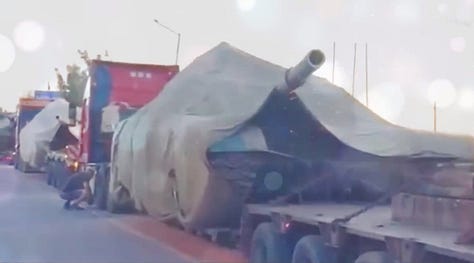
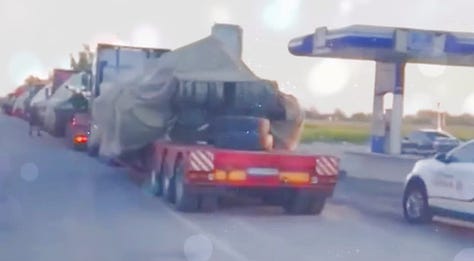

That’s not even a very good example, sloppily done with the turret still sticking out. But I’ve seen many photos of other transports that are far better covered and concealed where you would not even know that’s a tank under there. Add to the fact it’s often done at night to complicate it even further.
Plus, far fewer amount of actual MBTs have even been sent to begin with, so it’s not like we’re talking thousands of pieces. Ukraine has had a total of a few hundred MBTs delivered thus far, and all of that came in trickles. So it’s difficult to interdict tarp-covered trucks coming 1 or 2 at a time over the course of a year.
We’ve seen some delivered in the open on trains to the frontlines, but that’s typically from west Ukraine to the line. And in those cases Russia has often waited until they got to a collection point / depot and struck them there.
As to bridges, I’ve covered that in detail before but the quick gist of it is the giant Soviet era Dnieper bridges are far harder to destroy than they look and it would take hundreds of cruise missiles to do so, which Russia likely doesn’t have to spare for that. Putin himself admitted in an interview, whether he was being honest or not, that it’s not possible to destroy them all.
That’s not to mention there are said to be deals with the West for transport of Russian materials through Ukraine to Western countries for which Russia needs some of the railways/bridges functioning, anyway.
So what does that leave us with?
One of the remaining potentially effective ways you would normally interdict such things is with UCAVs flying around. But Ukraine still has a powerful air defense, and any UCAV large enough to be able to lob bombs/missiles (like the Inokhodets/Orion series, akin to U.S. Predator/Reapers) will be easily spotted and shot down all over Ukraine, just like Russia did to the Bayraktar TB2. You’ll notice drones on both sides stick to their side of the LOC and don’t really venture deep into enemy territory much, where they are prone to being immediately shot down by powerful AD systems. Russia manages to sneak some in pretty far sometimes but they’re usually much smaller recon ones, not the big ones you need to carry weapons platforms that could ‘interdict’ something.
That being said, I do think if Russia had a powerful drone fleet, better ISR capabilities, better SEAD capabilities, etc., etc., then it could make a much better go of interdicting such supplies. But UCAV drones are by far Russia’s biggest area of weakness, with SEAD and large scale ISR of that sort (in contrast to frontline ISR) not far behind, so unfortunately you’re seeing an area where Russia does not excel per se, and the results show. But it’s important to note that it’s mainly because of the distances and vast territories involved.
As I said, Russia could easily hit every road there with long range cruise missiles or suicide drones like the Geran, but what would that do? The roads would be repaired in an hour and they’d just have wasted millions in precious guided missiles.
Lastly—in case anyone’s forgot, the U.S.—which is said to be the greatest superpower—spent years “interdicting” ISIS and various other groups in a far more accommodating open terrain, with literally zero AD to worry about, and still couldn’t hit anything but the odd civilian transport, wedding, etc. In the Gulf War, the U.S. spent 9 months hunting Scuds and a special Pentagon report concluded afterwards that they didn’t find a single one:
Read this article to see how utterly difficult it is, and how the U.S. themselves could not do it: https://nationalinterest.org/blog/the-buzz/what-the-great-scud-hunt-tells-about-war-north-korea-22637
If the U.S. couldn’t “interdict” what Iraq wanted hidden, why should Russia be expected to interdict the combined forces of NATO, the most powerful military alliance in history? Plus, it’s not like Russia hasn’t interdicted a lot of it—it has. It’s killed a portion of their transports at railway hubs, etc. But ultimately the above reasons should give you a good idea of why it can’t get them all or even a majority of them.
If you enjoyed the read, I would greatly appreciate if you subscribed to a monthly/yearly pledge to support my work, so that I may continue providing you with detailed, incisive reports like this one.
Alternatively, you can tip here: Tip Jar







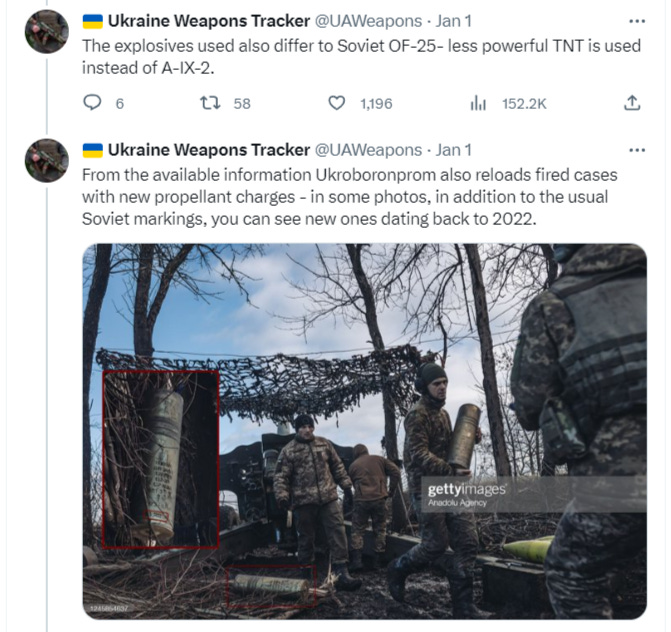
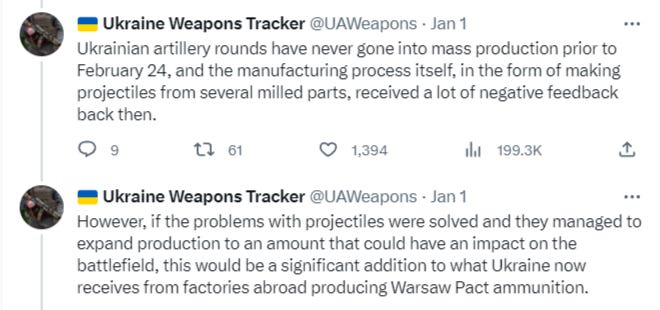
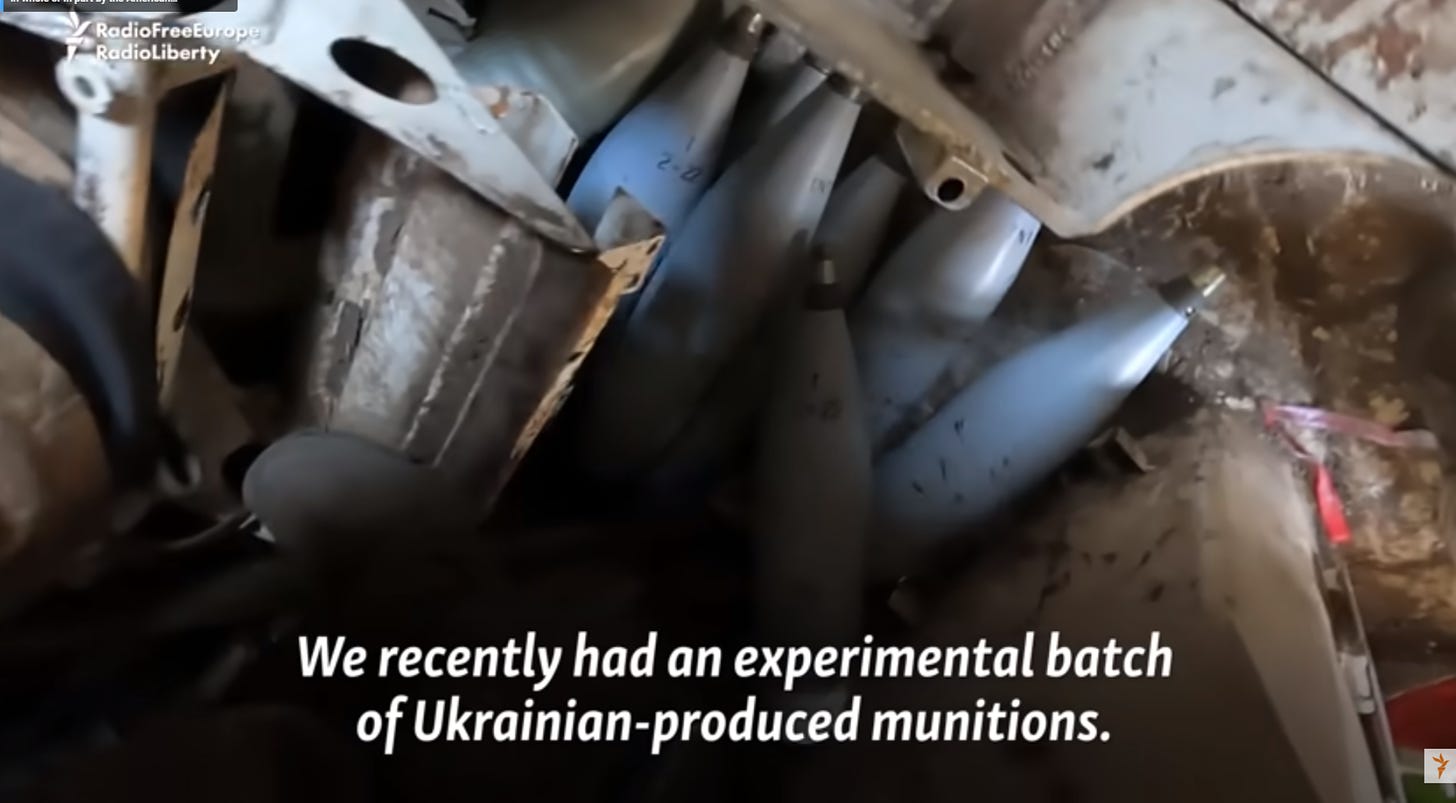

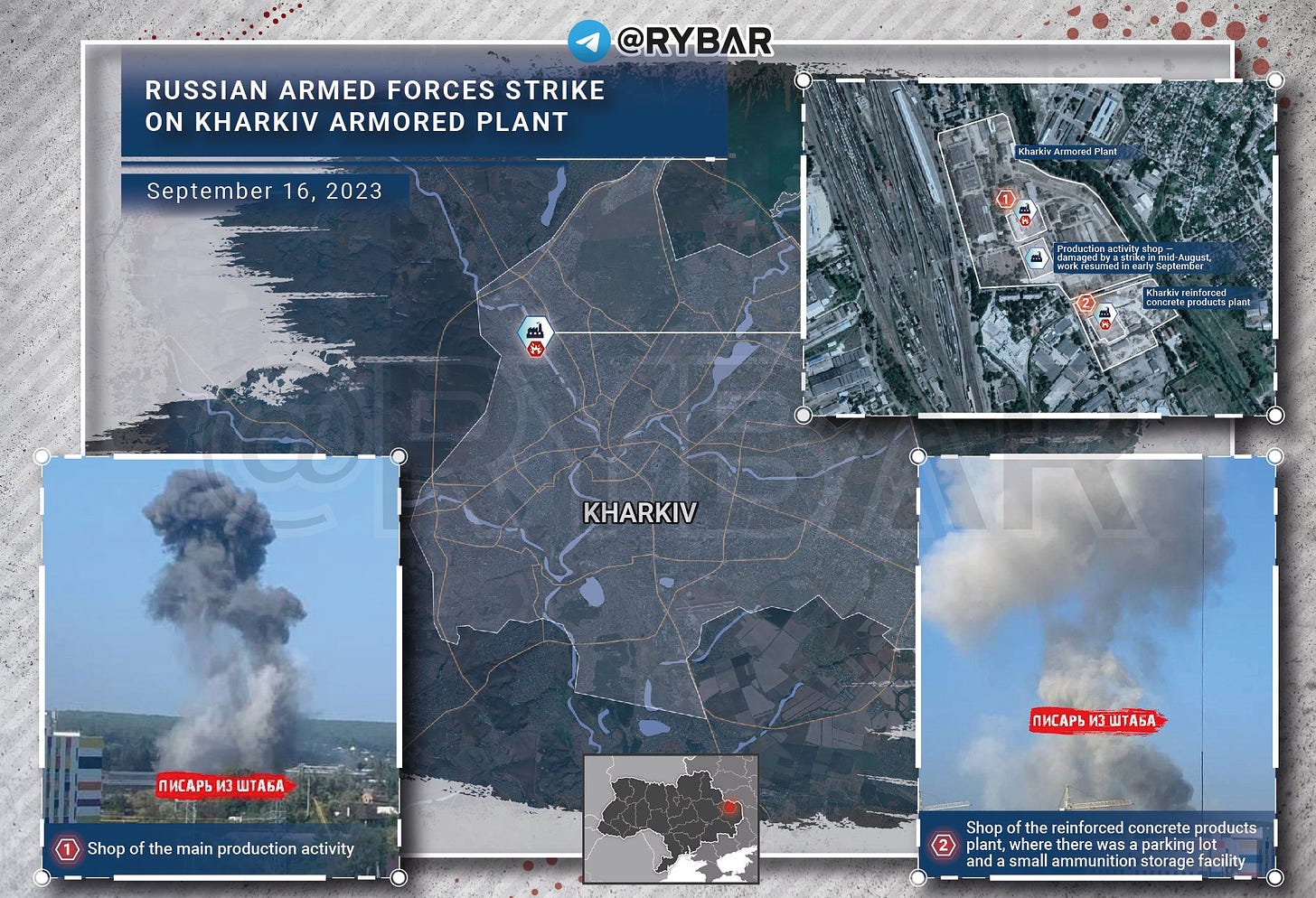
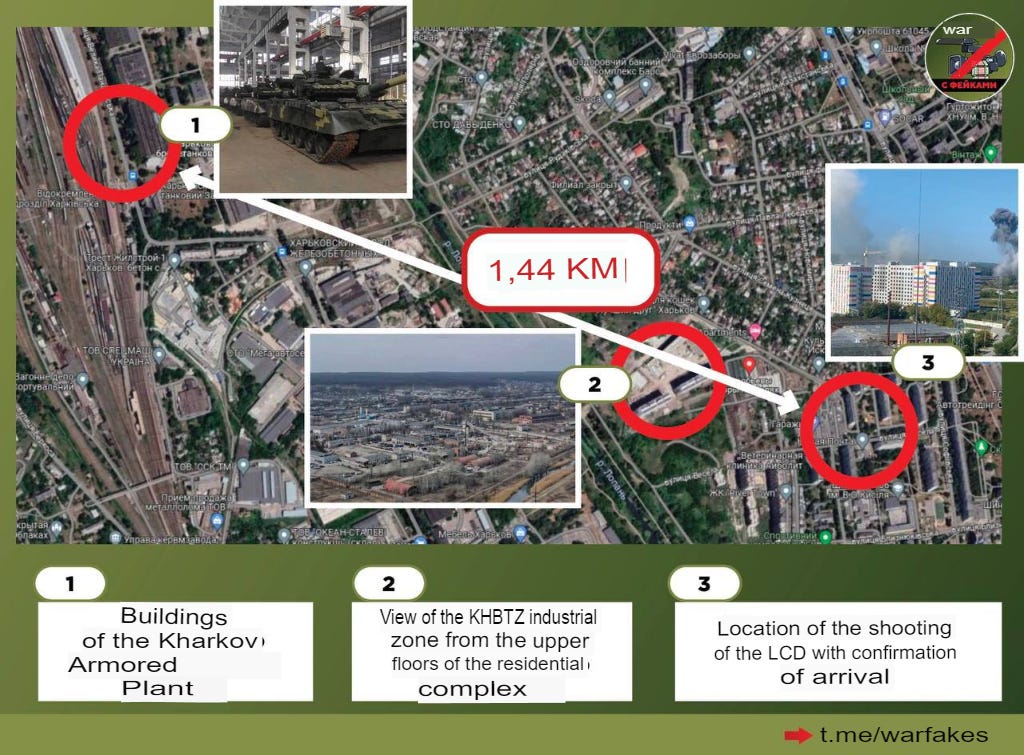
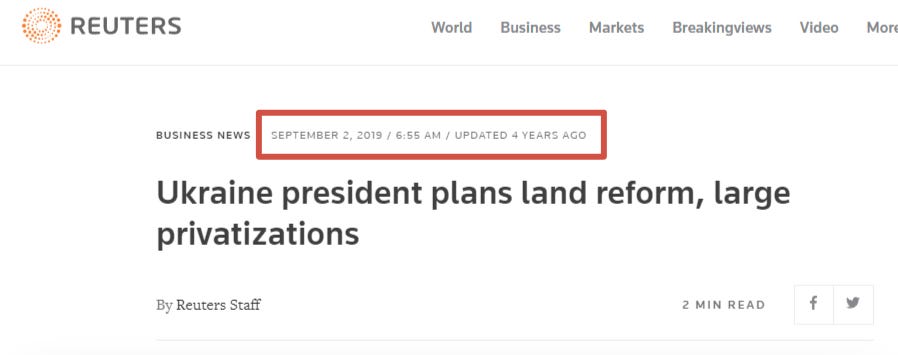
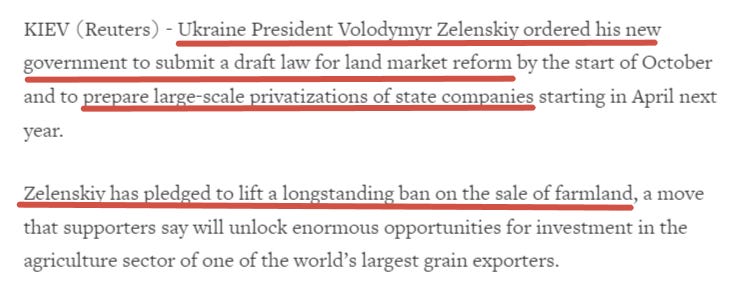

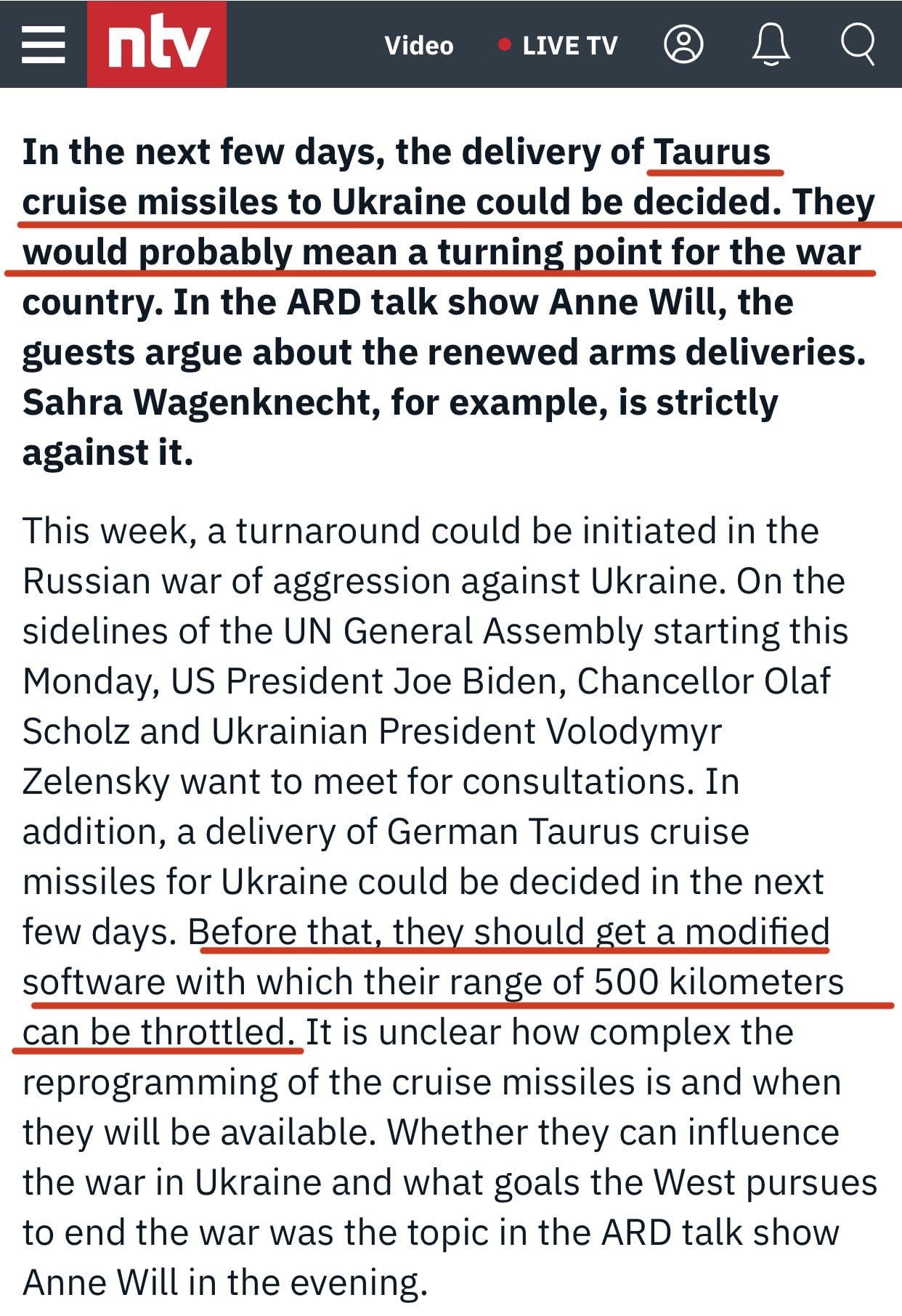

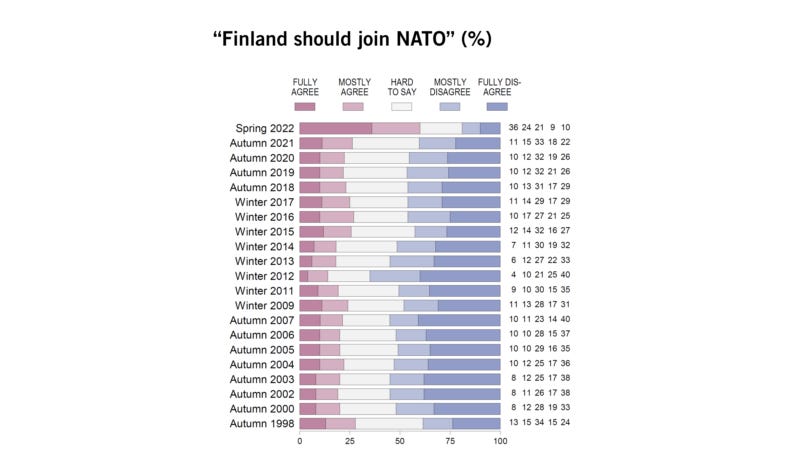


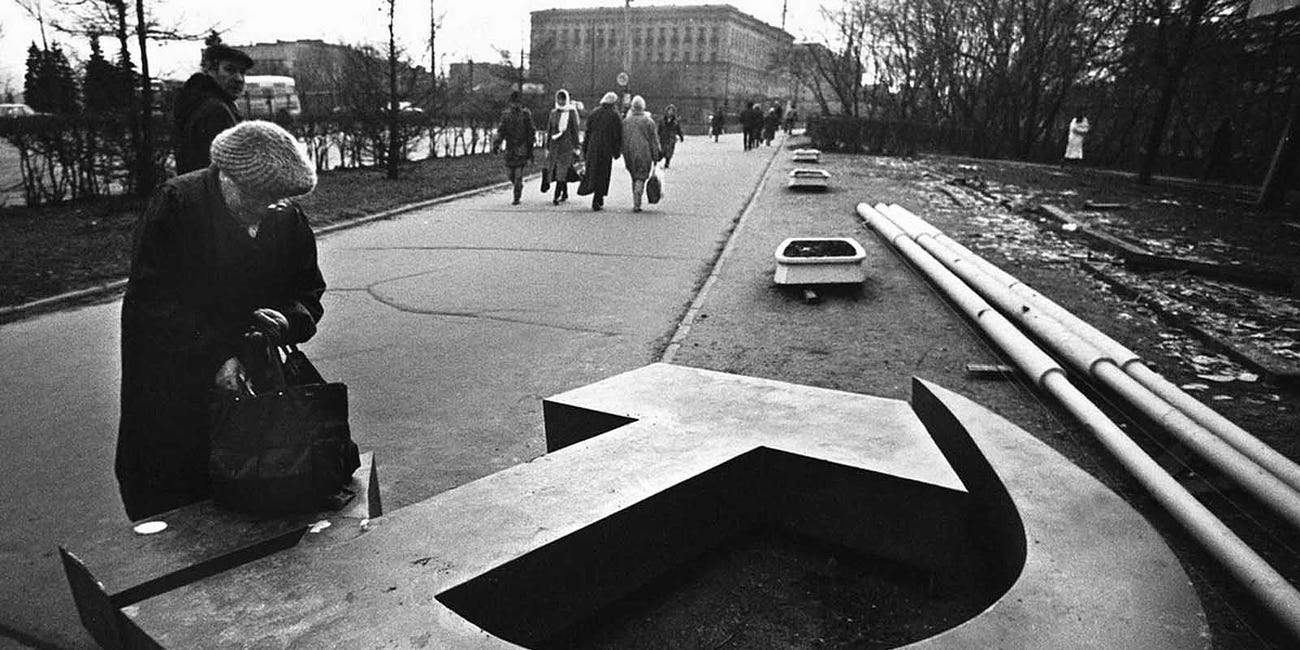
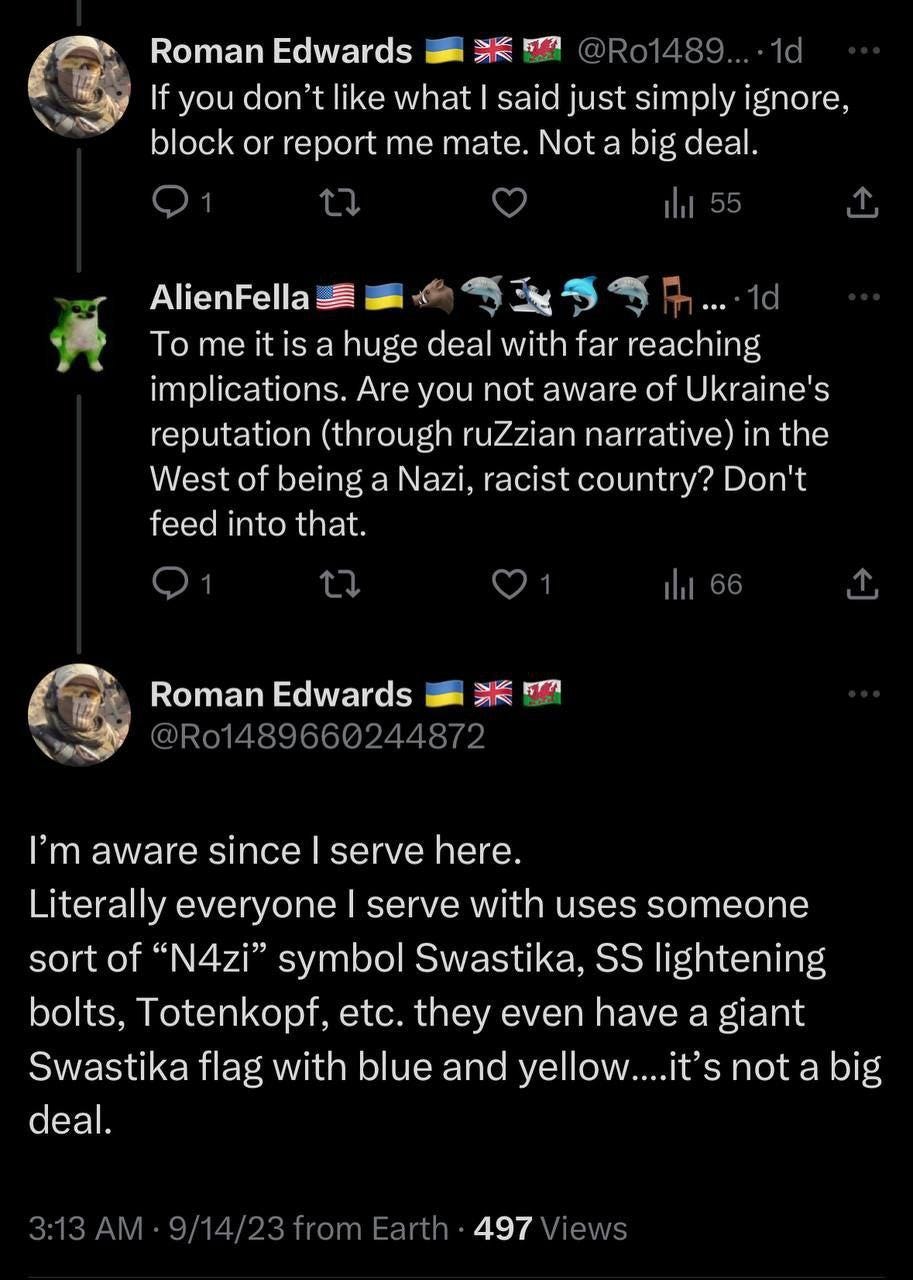
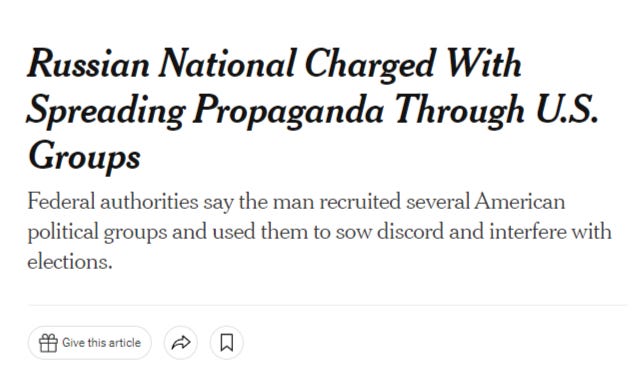

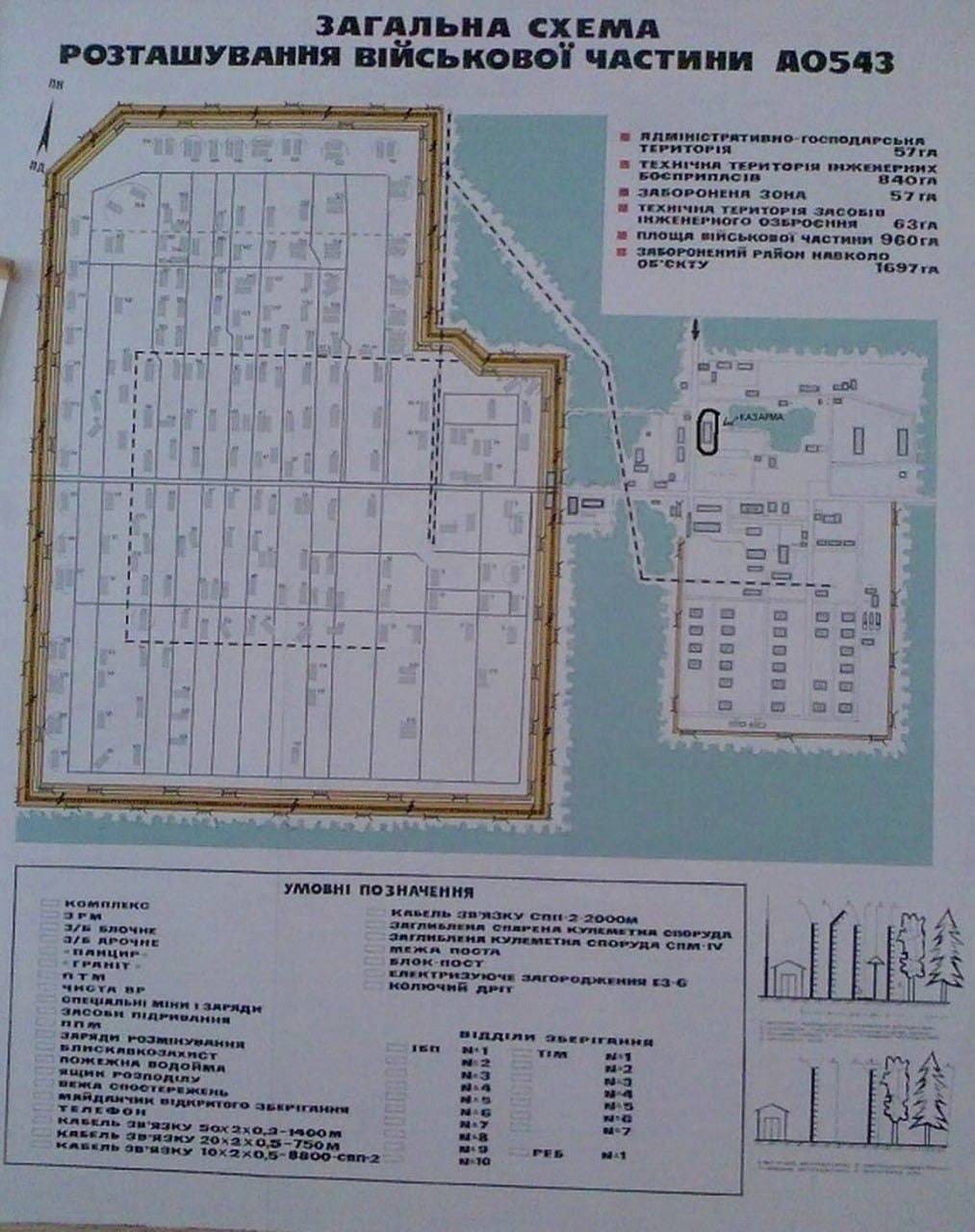

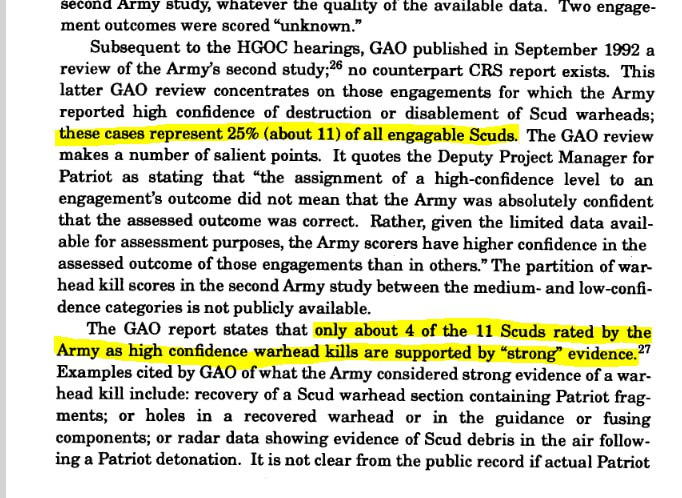

Incredible analysis. I totally agree with your timeline by the way. This will be over no time soon. For your stated reasons, and one more. Biden and the EU scum created this fiasco. Russia is going to let them stew in it for a while. Even if Russia could do an expensive and bloody major offensive and win it in one stroke? Why? They thought they would bleed Russia. Well, what if Russia bleeds them? And keeps this running herpes sore of a fiasco in the news thru the 2024 election cycle? And ala Spanish Civil War, Russia is learning every new Western WunderWaffen that the loons send in at rather minimal expense. And every day gets eventual elections by the European sheep closer.
I disagree on one point. Biden will not step down before the end of his term. And there is a damn good chance that they run/win/prop that zombie up for another 4 years. Do NOT underestimate the ignorance of the American electorate.
Thanks, I have been waiting , on edge , for my next hit of Simplicius. Now I can sit back and enjoy. Only thing better would be word that one of those British Challenger tanks ( or 10 ) got taken out over night.